- [email protected]
- (407) 401-2998
- Our Evolution
- Phoenix 32 XR
- Phoenix 34 XPR
- Phoenix 37 XPR
- Phoenix 37 XCC
- Phoenix 40 XCC
- Build Process


Uncompromising craftmanship Performance and Reliability
Every model from our 32 XR to the 40 XCC is handcrafted by the Chris Schoenbohm team.
Smart Performance Marine
Blending Art and Science
The Phoenix lineup of catamarans by Smart Performance Marine may be new to the consumer market, but their design and construction are the product of two decades of modifying, designing, rigging, and building high-performance outboard catamarans for offshore racing and pleasure boating.
Founder, owner and designer Chris Schoenbohm bought his first race boat in 2003 and won the Super Boat International (SBI) World Championships in 2014 driving a Doug Wright-built catamaran that he had cut in half, widened and modified heavily for better turning.
That boat’s modified running surface was the genesis of today’s Phoenix Variable Speed Running Surface, a third-generation design that places primary importance on handling, turning and driver feedback without sacrificing world-class acceleration, speed and efficiency.
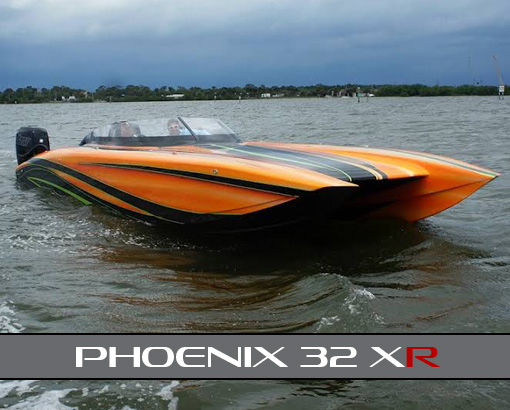
Every Phoenix is built to the highest standards in the industry with state-of-the-art engineered laminates and coring, epoxy resin, and full vacuum infusion of hulls, deck and bulkheads, yielding not only an exceptional strength-to-weight ratio but also class-leading safety. We back our hulls with a limited LIFETIME warranty.
Explore our lineup of performance offshore catamarans, including the purebred 32XR race boat, the 34XPR and 37XPR race-inspired poker run boats, and the innovative 37XCC and 40XCC, high-performance, air-packing catamaran with a versatile center console layout.
The Smart Performance Marine Difference
There are numerous catamaran speed boat manufacturers offering racing, poker run, and even center console configurations. they vary widely in performance, build quality, aesthetics, amenities, and, of course, price point. most of them represent a good fit for the right kind of buyer, whether that buyer is most concerned with speed, versatility, luxury, value, or some combination..
So where do Smart Performance Marine and the Phoenix line of catamarans fit in? We’re guided by an unwavering commitment to several key ideas and characteristics:
Safety and Strength
Building safe, strong boats is our utmost priority. Our designs, materials and construction techniques are tested and proven on the offshore racing circuit under the most rigorous conditions on the planet. No production Schoenbohm-built hull has ever failed on the race course or anywhere else. We’re so confident in our hulls that we offer a lifetime warranty against structural failure.
Superior Drivability
Anybody can go fast with enough power hanging off the transom. We emphasize speed and performance through design. The Phoenix running surface has been exhaustively refined not just for acceleration and straight-line speed but also superior handling, especially through turns. Our hulls provide proper driver feedback for comfort, confidence and fun behind the wheel.
Personalized Service
Higher-volume production builders can turn out more boats for fewer dollars than a smaller, semi-custom shop like Smart Performance Marine. But it’s important to us that buyers have the opportunity to see everything about how we build boats and to be an integral part of the construction of their own. Each of our boats is personally built by owner Chris Schoenbohm and a core team of craftsmen.
Solid Value
We’re not trying to be the lowest priced performance cat on the market, but we do strive to offer the best value. Counterintuitively, our 100% vacuum resin infusion process helps us do that by dramatically reducing waste of resin and other consumables and streamlining lamination. With resin infusion, we’re able to produce a lighter, stronger product using roughly half the resin and far fewer man-hours than would be required for conventional hand lamination or even vacuum bagging.
Racing Pedigree
Owner and founder Chris Schoenbohm is a widely experienced powerboat racer with a world championship under his belt. He has personally refined the Phoenix platform over the span of nearly a decade and is directly involved in the construction and rigging of every Smart Performance Marine boat. The Phoenix catamarans we build for our customers are identical in design and construction to the catamarans we race in the superboat stock class.
Innovation and Science
We innovate every day. Our team has a proven approach to creating some of the highest-performing catamaran boats available, but we never miss the to improve on everything we do. We constantly pay attention to our chemical mixtures, our infusion process, flow rates and ultimately weight and rigidity of every boat. Each boat includes a lifetime warranty that we fully back due to the quality, innovation and science used to hand-craft Phoenix boats.
Every Phoenix Boat has the DNA of a racer embedded right out of the mold.
Hull one from seven years ago launched a new breed of Phoenix boats with the industry's best running surface.
GET IN TOUCH
Feel free to contact us. we’d love to hear from you..
Selecting the perfect Phoenix boat is a life-changing experience. We welcome you to see first hand how we build and perfect each boat.
CALL US TODAY
407-401-2998
Send us an email.
Schedule A Visit
Visiting orlando, airport options.
Flying Private: Orlando Executive Airport is the closest option with excellent amenities.
Get Details >
Flying Commercial: Orlando International Airport is the hub for all major carriers and just a short drive to our headquarters.
- Transportation from local airports availble.
- Local accomodations available near local airports and attractions.
- Visit, get a tour, see how we build your next Phoenix boat.

Sail GP: how do supercharged racing yachts go so fast? An engineer explains
Head of Engineering, Warsash School of Maritime Science and Engineering, Solent University
Disclosure statement
Jonathan Ridley does not work for, consult, own shares in or receive funding from any company or organisation that would benefit from this article, and has disclosed no relevant affiliations beyond their academic appointment.
View all partners
Sailing used to be considered as a rather sedate pastime. But in the past few years, the world of yacht racing has been revolutionised by the arrival of hydrofoil-supported catamarans, known as “foilers”. These vessels, more akin to high-performance aircraft than yachts, combine the laws of aerodynamics and hydrodynamics to create vessels capable of speeds of up to 50 knots, which is far faster than the wind propelling them.
An F50 catamaran preparing for the Sail GP series recently even broke this barrier, reaching an incredible speed of 50.22 knots (57.8mph) purely powered by the wind. This was achieved in a wind of just 19.3 knots (22.2mph). F50s are 15-metre-long, 8.8-metre-wide hydrofoil catamarans propelled by rigid sails and capable of such astounding speeds that Sail GP has been called the “ Formula One of sailing ”. How are these yachts able to go so fast? The answer lies in some simple fluid dynamics.
As a vessel’s hull moves through the water, there are two primary physical mechanisms that create drag and slow the vessel down. To build a faster boat you have to find ways to overcome the drag force.
The first mechanism is friction. As the water flows past the hull, a microscopic layer of water is effectively attached to the hull and is pulled along with the yacht. A second layer of water then attaches to the first layer, and the sliding or shearing between them creates friction.
On the outside of this is a third layer, which slides over the inner layers creating more friction, and so on. Together, these layers are known as the boundary layer – and it’s the shearing of the boundary layer’s molecules against each other that creates frictional drag.
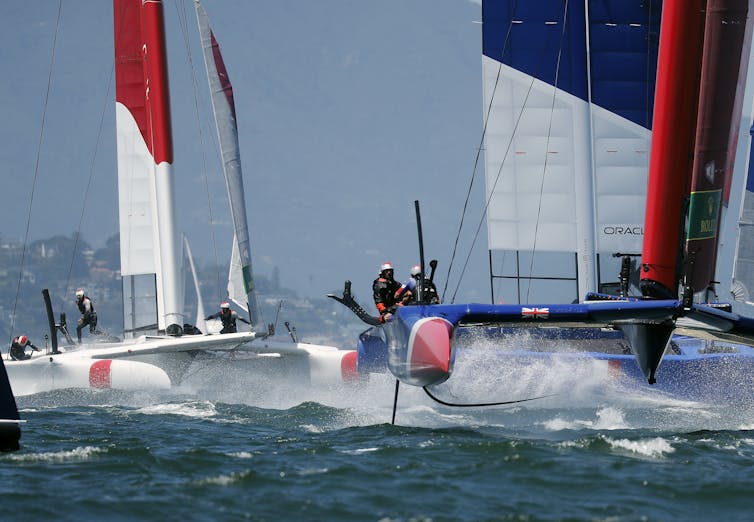
A yacht also makes waves as it pushes the water around and under the hull from the bow (front) to the stern (back) of the boat. The waves form two distinctive patterns around the yacht (one at each end), known as Kelvin Wave patterns.
These waves, which move at the same speed as the yacht, are very energetic. This creates drag on the boat known as the wave-making drag, which is responsible for around 90% of the total drag. As the yacht accelerates to faster speeds (close to the “hull speed”, explained later), these waves get higher and longer.
These two effects combine to produce a phenomenon known as “ hull speed ”, which is the fastest the boat can travel – and in conventional single-hull yachts it is very slow. A single-hull yacht of the same size as the F50 has a hull speed of around 12 mph.
However, it’s possible to reduce both the frictional and wave-making drag and overcome this hull-speed limit by building a yacht with hydrofoils . Hydrofoils are small, underwater wings. These act in the same way as an aircraft wing, creating a lift force which acts against gravity, lifting our yacht upwards so that the hull is clear of the water.
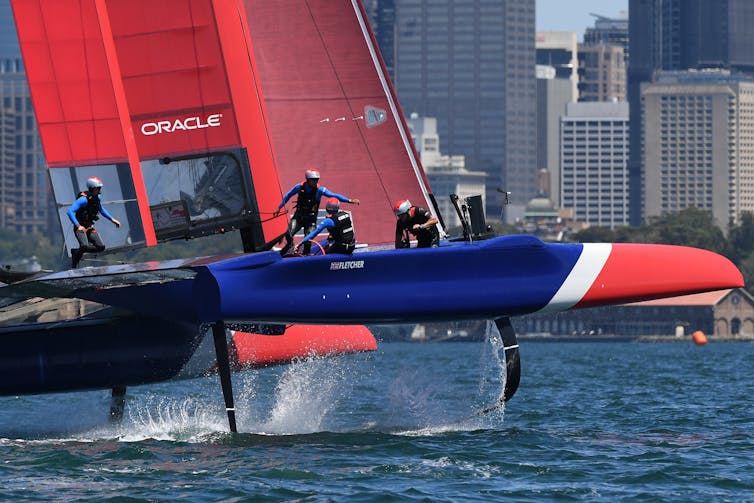
While an aircraft’s wings are very large, the high density of water compared to air means that we only need very small hydrofoils to produce a lot of the important lift force. A hydrofoil just the size of three A3 sheets of paper, when moving at just 10 mph, can produce enough lift to pick up a large person.
This significantly reduces the surface area and the volume of the boat that is underwater, which cuts the frictional drag and the wave-making drag, respectively. The combined effect is a reduction in the overall drag to a fraction of its original amount, so that the yacht is capable of sailing much faster than it could without hydrofoils.
The other innovation that helps boost the speed of racing yachts is the use of rigid sails . The power available from traditional sails to drive the boat forward is relatively small, limited by the fact that the sail’s forces have to act in equilibrium with a range of other forces, and that fabric sails do not make an ideal shape for creating power. Rigid sails, which are very similar in design to an aircraft wing, form a much more efficient shape than traditional sails, effectively giving the yacht a larger engine and more power.
As the yacht accelerates from the driving force of these sails, it experiences what is known as “ apparent wind ”. Imagine a completely calm day, with no wind. As you walk, you experience a breeze in your face at the same speed that you are walking. If there was a wind blowing too, you would feel a mixture of the real (or “true” wind) and the breeze you have generated.
The two together form the apparent wind, which can be faster than the true wind. If there is enough true wind combined with this apparent wind, then significant force and power can be generated from the sail to propel the yacht, so it can easily sail faster than the wind speed itself.
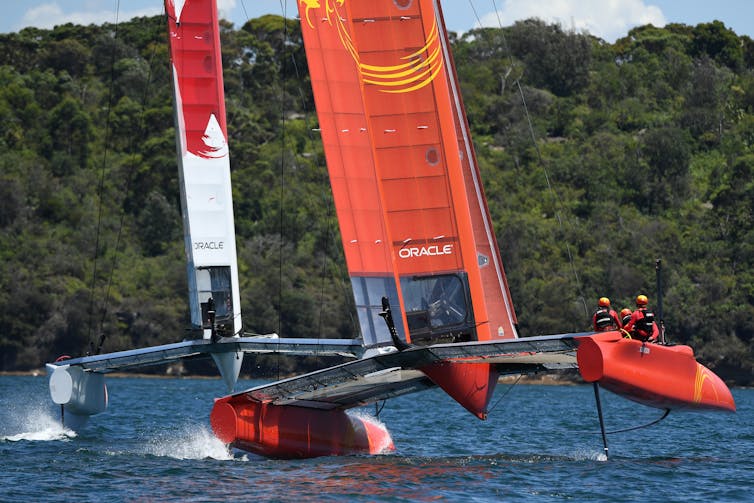
The combined effect of reducing the drag and increasing the driving power results in a yacht that is far faster than those of even a few years ago. But all of this would not be possible without one further advance: materials. In order to be able to “fly”, the yacht must have a low mass, and the hydrofoil itself must be very strong. To achieve the required mass, strength and rigidity using traditional boat-building materials such as wood or aluminium would be very difficult.
This is where modern advanced composite materials such as carbon fibre come in. Production techniques optimising weight, rigidity and strength allow the production of structures that are strong and light enough to produce incredible yachts like the F50.
The engineers who design these high-performance boats (known as naval architects ) are always looking to use new materials and science to get an optimum design. In theory, the F50 should be able to go even faster.
- Engineering
- Aerodynamics

Deputy Editor - Technology

Sydney Horizon Educators (Identified)

Assistant Grants Officer

Deputy Vice-Chancellor (Academic and Student Life)

Visiting Professor - 2024-25 Australia-Korea Chair in Australian Studies at Seoul National University
Yachting World
- Digital Edition

Performance cruisers: the best new catamarans for racing and fast cruising 2018
- Toby Hodges
- August 20, 2018

This is where the worlds of racing and cruising multis meet, where we see high-tech lightweight craft that use exotic materials and daggerboards to help produce electrifying sailing. Gunboat was arguably the first to identify this market on a luxury level, and has since been joined by HH, McConaghy, Ice Cat, and ITA.
And then there are the performance multis that are more minimalist and lean more towards the offshore racer than cruiser – like Marsaudon, Dragonfly, Banuls, Dazcat, and Rapido… fun factor guaranteed!
Just launched: McConaghy MC50

Fresh from the Australian composite wizards McConaghy, the MC50 is the smallest series catamaran in a new range that runs up to 90ft. Drawn by Jason Ker, renowned for his IRC winners, the MC50 has performance in her DNA, designed as a fast cruising cat, capable of crossing oceans. The MC line has incorporated input of experienced owners and sailors, and includes some impressive features. For example, the doors between the saloon and the cockpit concertina, while the saloon windows slide open electrically for al-fresco living. A skylight down the middle of the coachroof lets light flood in, and can be specced as a large ‘solar glass’ generator to keep batteries topped up. Then there is the standard cross brace between the bows, which has been eliminated by using a carbon fibre longeron down the boat’s centreline, tensioned with Nitronic rod stays. The first hull launched in time for La Grande Motte boatshow in April and the performance predictions are bold. Polars from McConaghy suggest speeds of over 10 knots in a stiff Force 6, at 30° off the true wind. Bear away onto a broad reach and she is expected to manage 21 knots-plus. Upwind performance is boosted by 3.5m-deep hydraulic daggerboards in each hull, which include a fail-safe in the event of underwater collision. “We expect her to track upwind extremely well,” says James Kinloch of McConaghy. And yet this is no pared-down raceboat. The saloon has deep seating to starboard and an extending table gives dining space for at least eight, and can convert into lounging room if you drop the table and install the fill-in cushion. The galley and island unit to port are more penthouse than deckhouse, with induction hob and moulded-in sinks. Sensibly, there is a navigation station at the forward end of the saloon, with good visibility ahead and access to all the systems. The styling was undertaken by Design Unlimited. “The concept was to create a penthouse apartment on the living deck,” says Ole John, director of McConaghy Multihulls Europe. “The 35-40m2 of space must be the biggest for a 50ft yacht.”

First impressions

The MC50 is a clever boat. A Ker/McConaghy project, it might be expected to be all about the performance. That has yet to be proved, but the first MC50 to launch stole the show at its La Grande Motte debut in April thanks to the sheer amount of open-plan living space it offers. The natural light and ventilation offered by using sliding doors and windows needs to be seen to be believed, and the general feeling is that of a condo/apartment on the main deck. The view from the helms on the aft flybridge is excellent, but I wonder how these relatively high positions will feel in a rolling sea. The most impressive aspect for me, however, is the engineering detail, something Ker is known for. It can be seen in the length to which he and the yard has gone with the mast base and bowsprit longeron supports, and the hydraulic centreboards that swing into the hulls. The latter offer a clever solution to the problem of providing the performance benefits of 3.5m-deep boards without swallowing excessive accommodation space. The boards have fail-safe pins that break in a collision without risk of leaking hydraulic fluid; and they take just 12 seconds to raise. This is a boat that we are itching to sail.
At a glance…
LOA: 49ft 10in (15.20m) Beam: 26ft 3in (8.00m) Draught: 3ft 3in – 8ft 10in (1.00m – 2.70m) Displacement: 14.5 tonnes Price: from €1.33m Contact: McConaghy
Just launched: ICE Cat 61

Italy’s ICE Yachts has been on the scene since the turn of the millennium, but it is only now making a foray into multihulls. And it is starting big, with a 61, and a 67 further down the line. Its calling card has always been style at the service of performance, and the cats will be no different. Enrico Contreas has designed a dashing hull with just a hint of reverse bow and a long, curved quarter. It’s stylish, but also practical. “Avoiding highly reversed bows allows for easy recovery of the mooring lines,” says Marco Malgara, ICE Yachts’ CEO. Likewise, the shallow curve of the coachroof is more than just a flick of the designer’s pen: it is intended to reduce windage and help the catamaran go to windward. This is one reason that she can reportedly manage near 30° true wind angles. Another is the manually-operated carbon foils that reduce her displacement by about 15 per cent, and the way the rig is designed. “The angle going to windward is almost like a monohull,” Malgara says.

The yachts are built using ultra-modern techniques. On the standard version, the hull and superstructure employ a mix of glass and carbon fibre vacuum-infused with epoxy to ensure that just 35-40 per cent of the final weight is resin. Everything on the boat is foam-cored. Customers have so far unanimously opted for the RS version of the 61, which uses all carbon fibre. ICE has tried to mitigate the handling of a large, technical boat with electric winches and a self-tacking jib. The sheets of both sails are on travellers, giving maximum sail trimming options and a tighter sheeting angle for better windward performance. The helms are towards the aft end of the cockpit, behind a pod-like console, giving the skipper more the sense of a monohull. Dispensing with a raised helm station keeps the boom and the centre of gravity low, making for a more comfortable ride and better performance, predicted at 25 knots. The interior is more architectural than your average luxury yacht. Expect more of a kitchen than a galley in the large open space of the saloon. The configuration allows for three, four or five cabins, including a compact crew berth in the starboard bow.
At a glance…
LOA: 61ft (18.60m) Beam: 28ft 3in (8.60m) Draught: 3ft 3in (1.00m) Displacement: 15 tonnes Price: From €1.35m Contact: Ice Yachts
Coming up: HH50

HH Catamarans has been turning heads since 2012 with a line of sporty, high-tech boats that feature a luxury fit-out. What started off on the drawing board as a fast 48ft cruising cat has grown to 50ft in the building. “One of the biggest reasons was the addition of a second helm station aft,” explained marketing manager Will Hobbs. “That and, during the design review, we found we were able to increase sail efficiency by 6 per cent if we lengthened the hull.” The lay-up is all carbon, with twin bulkhead helm stations and long-skirted hulls. With a self-tacking jib and push-button controls at the helm station, she should be a breeze to sail short-handed. Her accommodation all looks very elegant – dark teak contrasting with lighter fabrics. The saloon windows are huge, letting light gush in, with a semi-horseshoe galley to starboard, a navstation forward and dining table to port. There are configurations allowing for three or four cabins. Morelli & Melvin’s design generally looks modern and aggressive (even if we question the aesthetics of the hard biminis above the helms).
LOA: 49ft 10in (15.20m) Beam: 24ft 4in (7.44m) Draught: 4ft 11in-10ft 6in (1.50m-3.20m) Displacement: 15 tonnes Price: Tbc Contact: HH Catamarans
Just launched: Marsaudon TS5

Even if you haven’t heard of Marsaudon, you’re likely to be familiar with its work. The Brittany-based boatbuilder is responsible for some of the world’s biggest and fastest multihulls, including the trimaran IDEC 2, in which Francis Joyon demolished the round-the-world record in 2008. Operating out of an old U-boat pen in Lorient, France, this composite expert has only been crafting its own brand of cruising catamarans for a few years, but it has already become its mainstay. It began with the TS42, which has reached 10 units, then the well-regarded TS50. The new TS5 is a remodelled version of this, with all-new tooling and a length overall of 55ft. Even before the first one hit the water, half a dozen boats had been pre-sold, such is the reputation of this builder.

LOA: 49ft 10in (15.20m) Beam: 28ft 3in (8.60m) Draught: 3ft 11in-9ft 10in (1.20m-3.00m) Displacement: 8.6 tonnes Price: from €620,000 Contact: Marsdon Composites
Coming up: ITA 14.99

ITA Catamarans is a new brand, but the team behind this 14.99 are no strangers to the trade and have experience from many of the major Italian shipyards. The naval architecture is by Francois Perus, whose Yacht Design Collective has worked with brands such as Catana and North Wind on their multihulls. The result is a sleek-looking craft with stylish dreadnought bows and refreshingly low-profile coachroof. This sets the tone for the boat, due to launch this summer, which is all about stellar performance within the envelope of a fast cruiser. Take the twin helm stations, for instance – they are perched on the aft coaming. This frees up the cockpit for socialising, without compromising the boat’s stability by putting the weight of the helm on the coachroof. The result looks as if it could feel exposed in bad weather, although there is a wraparound seat, and the Jefa pedestal can swing inboard if necessary. The outer position gives you optimal views ahead and to windward. The dreadnought bows are designed to give extra waterline length for speed, while the long, fine underwater profile of the hulls is optimised for comfort through the waves. The flatter sections aft mean that she should plane at speed, and the winch-trimmed daggerboards improve performance to windward. High-tech foam sandwich lay-up and the use of carbon fibre in key areas keeps the hulls light and stiff.

There should be plenty of power from her fathead main and self-tacking jib. “Since most cruisers consists of one couple for sailing, the deck and running rigging had to be of a design so that one person can easily manage all sailing manoeuvres from the safety of the cockpit,” says Sonia Segato, head of marketing at ITA Catamarans. The mainsheet runs back to blocks on the aft crossbeam, where Harken 50 winches are within easy reach of the helm. It is a set-up that has worked well for monohull sailors, and this boat’s low profile coachroof makes it possible here too. The designer’s ambition is clearly bluewater, because the boat’s equipment and latest technology includes a Schenker watermaker and Oceanvolt electric propulsion, backed up with twin regenerating props that allow you to recharge the lithium-ion batteries as you sail. There’s scope for owners to choose their own interior design. “Nothing is set in stone”, says ITA. The heart of the boat is its comfy saloon, which has wraparound toughened glass windows, and the starboard hull is turned over to the owner’s suite. There are several configurations to choose from, including one with an office and another with bunks. Weight management is taken very seriously. The complete hulls weigh 2,250kg, and the whole boat is infused in one shot to come in under five tonnes. The first 14.99 will be shown at Cannes, before the owner takes it on a circumnavigation.
LOA: 49ft 2in (14.99m) Beam: 25ft 7in (7.80m) Draught: 1ft 10in-7ft 8in (0.57m-2.35m) Displacement: 14.5 tonnes Price: €890,000 Contact: Itacatamarans
Coming up: Gunboat 68

Gunboat is back to what it does best with a show-stopping design for a 68ft oceanic catamaran. An all-carbon build again, the new 68 has heavily reversed wave-piercing bows and super low-profile coachroof, giving it an elegant but muscular look. There’s something of Gotham City about this yacht. Gunboat, which is now under French ownership, has brought in VPLP design for the naval architecture. They are veterans of some of the world’s biggest, fastest racing multihulls. The design team has broadened the beam of the boat and moved the mast further aft to make her more stable and easier to handle. That said, she’ll be no slouch, particularly if you select some of the turbo options, including longer rig for bigger sails, lighter weight and longer daggerboards. Speeds in excess of 25 knots in a blow, and up to 16 knots in a Force 4 are predicted. Benoit Lebizay, Gunboat’s managing partner, says: “500 miles per day is an achievable target”.

LOA: 68ft (20.75m) Beam: 29ft 11in (9.1m) Draught: 3ft 11in-13ft 6in (1.20m-4.10m) Displacement: 23.8 tonnes Price: from €4.75m Contact: Gunboat
Best of the rest:
Unlimited yacht c53.

Vittorio Malingri, Italy’s first Vendée Globe sailor, is the nautical brain behind a new fast cruising catamaran, christened the Unlimited C53. With no website, his is a stealthy operation, but the first hull is sold and already in-build on the Adriatic coast between Ancona and San Marino. The boat has been designed with an experienced navigator’s eye, so the beams connecting the two hulls are an unprecedented 1.3m above the waterline, to minimise slamming in heavy seas. Tankage and heavy equipment are all positioned low and in the centre of the hulls for balance. And there is a heavy longeron, which makes for a stiffer forestay and therefore better windward performance. The twin helms are on swinging pedestals, and the boat uses foils and T-shaped rudders to provide lift to windward. There are three broad specification levels, depending on budget, with the top spec including full carbon lay-up.
Dazcat D1295

Launched at the end of last season, the D1295 is a potent new addition to the cruiser-racer cat market. It is the smaller sister to the very impressive D1495 we tested two years ago and leans on more than three decades of successful offshore racing builds from this Cornish yard. These cats can outrun weather or look after crew if caught out. Weight is kept low and central, including the engines, to create a fast smooth ride. It is also minimised wherever possible, with carbon used for the rudders, spinnaker pole V-striker, davits and bimini sections. “She points really high and is the fastest tacking Dazcat so far,” says Dazcat designer Darren Newton. “We did a two-second tack where she lost no momentum at all, which for a cruising cat is phenomenal!”

6 Best Performance Cruising Catamarans (Buyer’s Guide)
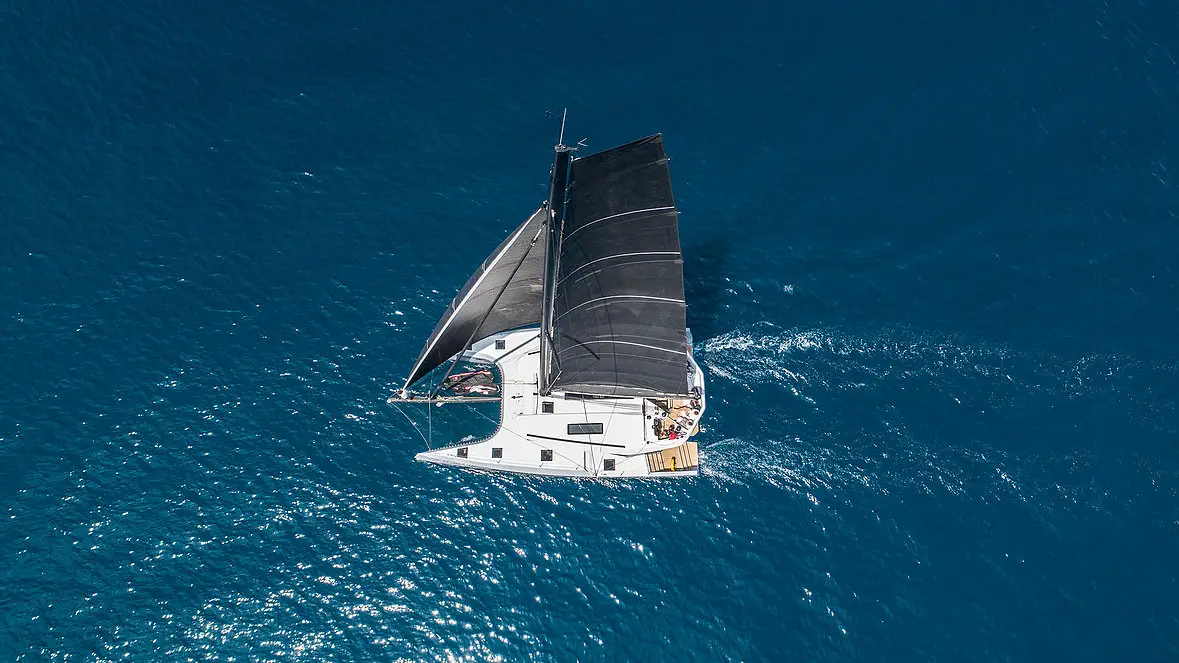
As an Amazon Associate, we earn from qualifying purchases. We may also earn commissions if you purchase products from other retailers after clicking on a link from our site.
Performance cruising catamarans are impressive-looking vessels that focus on speed above comfort. These fast boats are ideal for racing and long cruising vacations. But with the numerous brands and models on the market, how do you know which is the best one?
The best high-speed performance cruising catamarans are the Outremer 4x, McConaghy MC50, Nautitech 44, Gunboat 62, Balance 526, and Marsaudon Composites ORC50. All these boats deliver outstanding speeds and are light in weight, relatively comfortable, and incredibly safe.
This article will explore the brands and models that I believe have the best combination of performance and comfort . We’ll look at their speeds and what makes them cruise so fast. We’ll also examine the factors to consider when shopping for a performance cruising cat.
Table of Contents
How Fast Are Performance Cruising Catamarans?
Cruising catamarans are generally faster than monohulls of similar lengths. This means most well-built and well-balanced cats will arrive at their destination much sooner, and the cruise is much more comfortable. Performance cruising cats like the Nautitech include deep daggerboards and rudders, narrow waterline beams, hull chines, and big sail plans that allow for faster sailing than a standard cruising cat.
Outremer 4X
Outremer Catamarans are well-known for their high speeds. These exciting cats sport brilliant designs, narrow bows, and large rigs. Built in Southern France, the vessels are strong and long-lasting since their structures feature materials such as carbon, glass, and vinyl ester.
The Outremer 4x is a stable and comfortable high-speeding cruising catamaran that performs ocean crossings and confronts any weather with remarkable ease. Named the European Boat of the Year in 2017, this 48-foot (14.6 m) bluewater cruiser sails faster than wind speed and attains maximum cruising speeds of 20 knots.
The 4x is an upgrade of the extremely popular Outremer 45, thus retaining Outremer’s core values of speed, safety, and comfort. It’s built for maximum performance and enjoyment, with the lightweight, carbon fiber structure allowing for additional speed under sail .
Featuring comfort typical of much larger vessels, the Outremer 4X features 4 double cabins, hot water showers, a full kitchen, spacious storage, and excellent ventilation. There’s also an expansive deck, an unobstructed cockpit, and large trampoline areas. Most importantly, your safety is assured through the cat’s unique features including a robust structure, offshore design, stability, and unrivaled speed potential.
The 4x’s cutting-edge design makes it ideal for competitive racing or blue water cruising, and it does both without compromising your comfort, safety, or onboard livability. However, to sail at maximum speed, the boat must remain lightweight, requiring your interior to be fitted out quite minimally. The other downside is the high price tag; the Outremer 4X commands a price between $912,322 and $1,202,945 .
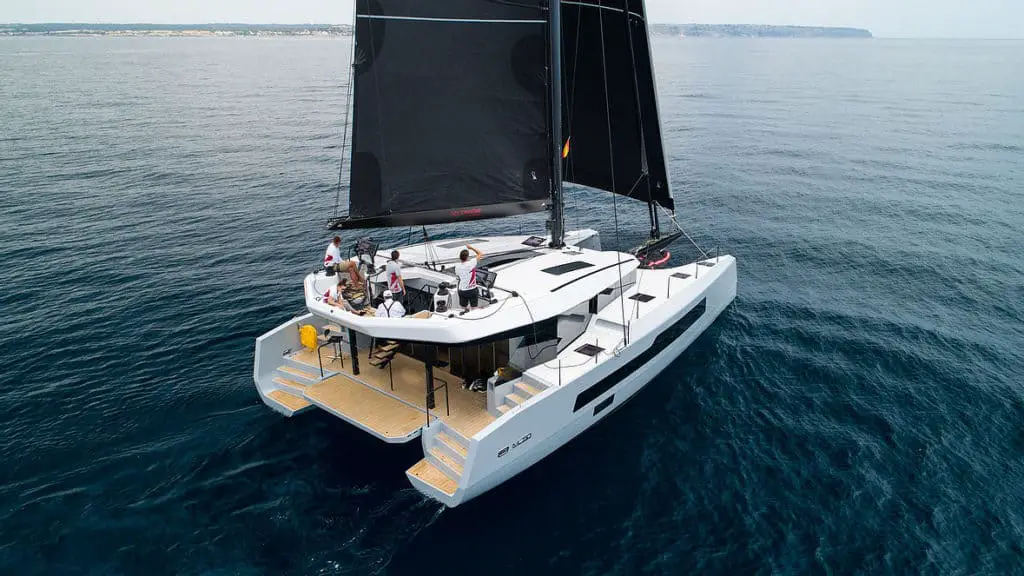
McConaghy MC52
The McConaghy MC52 is a performance luxury cruising cat reflective of McConaghy’s 50 years of experience in building high-tech composite projects. The luxurious boat features a flybridge, retracting centerboards, optimized hulls, and an open space bridgedeck combining the salon with the cockpit. You can also customize the boat to your specifications.
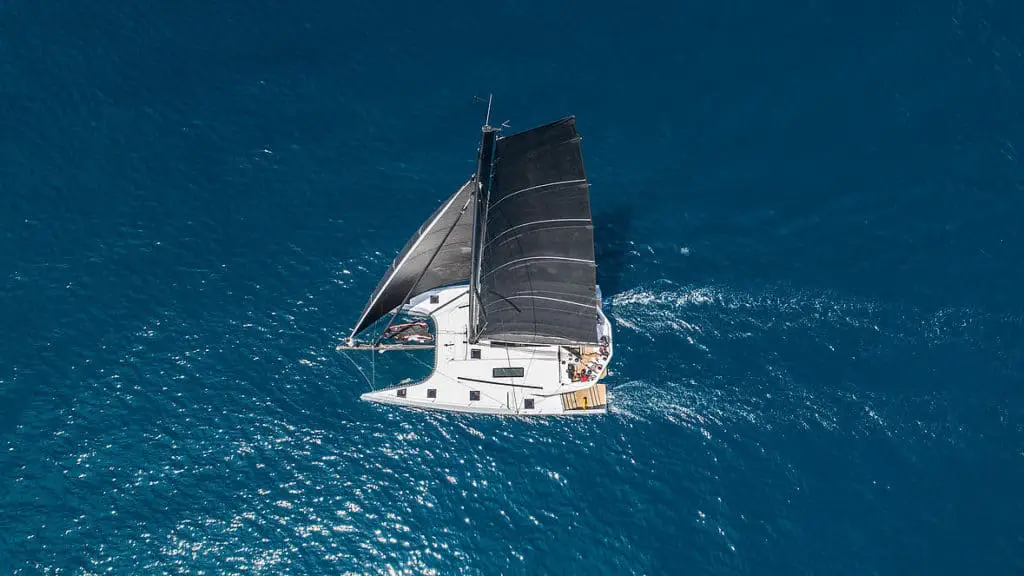
This hi-tech cat comes with sizeable sliding salon windows and frameless doors that provide fantastic views. Its wave-piercing bows can cut through waves, thus helping to increase performance by minimizing pitch resistance, while still retaining a smooth ride. Also, the saloon offers spacious dining space for up to 8 people, and the galley area is more like a penthouse.
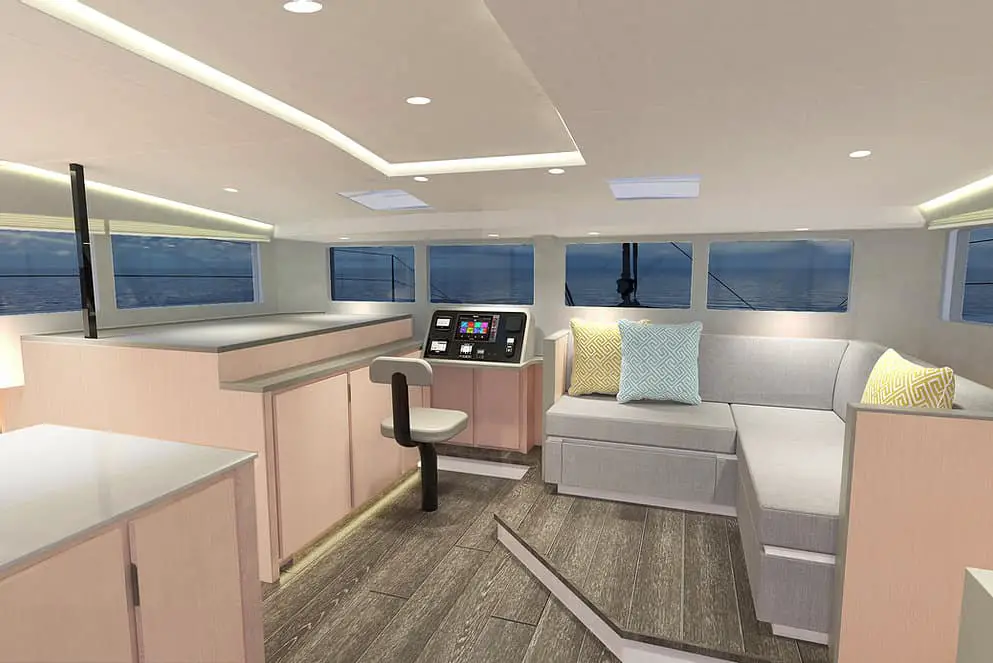
The manufacturer’s background in building high-end racing yachts has resulted in an incredibly strong and lightweight vessel capable of reaching 22 knots (40.7 km/h or 25.29 mph). The main downside to this boat is the boom placement on the mast, which is much higher than other high-performance cats. This makes accessing the mainsail somewhat challenging. It also increases the MC50’s center of gravity and center of effort.
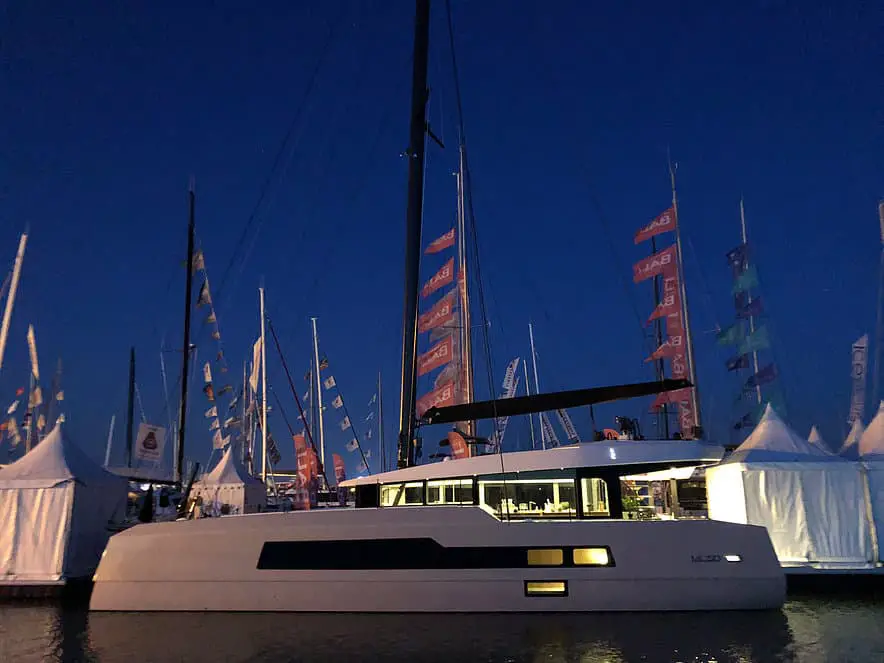
You can get the MC52 for about $1.6 million.
Nautitech 44
The Nautitech 44 easily blends comfort and fun to deliver an impressive sailing performance, whether you take short trips or long ocean crossings. The boat offers a good balance under sail, and it features helming stations on each hull. Plus, there’s an integrated hardtop bimini complete with sunroof opening. Slim hulls translate to higher speeds, with the vessel reaching up to 17 knots (31.4 km/h or 19.51 mph).
The well-laid-out interior boasts a functional design, ample storage space, plus all the equipment you require for ocean cruising, such as a fridge, watermaker, and solar.
Nautitech 44’s twin helms give you the real sailing experience with a fantastic view of the sails and great visibility when maneuvering into port. However, you might not appreciate being stuck in the aft helm position without protection in lousy weather or during hot days.
Nevertheless, the boat’s responsiveness makes sailing more pleasurable. Plus, it’s affordable; the price is between $236,000 and $334,000.
Marsaudon Composites ORC50
Marsaudon Composites vessels are ideal for both racing and cruising. The sporty-looking ORC 50 comes with large inverted bows, an angular coachroof, a high freeboard, and a sturdy rotating carbon mast. In addition, the vessel is light which allows it to accelerate quickly, while the angular coachroof offers lots of space and excellent visibility.
The ORC50 can attain 23+ knots (42.5+ km/h or 26.41+ mph) and is among the fastest high-performance livable multihulls. It’s capable of doing more than 350 miles (563.27 km) per day.
The downside to the ORC50 is it’s a bit technical to sail, thus requiring a skilled sailor. Furthermore, its immense power and speed can be intimidating to less experienced sailors. Solely designed for speed, the ORC50’s interior is simple, less roomy, and somewhat spartan; hence the boat might not be all that comfy. Still, it’ll get you where you want to go pretty fast, and it’s an excellent value for money at approximately $787,751.25.
Gunboat 62
The Gunboat 62 is a true high-speed catamaran capable of sailing at 20 knots (37 km/h or 23 mph) over true wind speeds and known to notch up speeds of 36+ knots (66.7+ km/h or 41.45 mph) on a surf. The initial 3 Gunboat 62 boats featured epoxy, E-glass, and carbon fiber construction, but the fourth vessel was all carbon, sported a taller rig and a more expansive sail area.
These structural features made the Gunboat 62s extremely light, and they formed the original luxury high-performance cruising cats.
This multihull sailboat boasts a carbon mast, round hull sections for a minimized wetted surface area, high-aspect rudders, and retractable daggerboards. The steering station offers 360-degree visibility and sports overhead hatches that you can use to monitor the mainsail trim. The boat also contains 3 private cabins with queen berths, 2 spacious heads with showers, an aft cockpit, galley, and lounge.
On the downside, Gunboats are pricey cats; hence they’re also expensive to maintain. The Gunboat 62 isn’t that spacious either as it’s more focused on speed, but it’s extremely comfortable, plus there’s plenty of space for hanging out. You can buy this catamaran starting from $2 million .
Balance 526
Built with a combination of carbon fiber, E-glass, epoxy, closed-cell foam, and composite bulkheads, this boat is strong, light, and can withstand terrible weather. The retractable daggerboards allow for good upwind performance. All high load areas contain carbon fiber, while furniture and cabinets feature cored sandwich construction, producing the lightest yet most robust catamaran.
A Balance 526 will reach speeds of up to 20knots without stressing the rig too much.
The boat is available in various layouts and comfortably accommodates 6 people. The spacious aft cockpit and saloon provide panoramic visibility. And since Balance 526 can handle the extra weight, you get performance plus all the creature comforts you desire.
Still, Balance 526’s pricing is on the higher end, beginning at $1,440,000 . Also, the slender hulls result in less space down below. Nevertheless, the boat lives up to its name, achieving the perfect balance between superb performance and comfort.
What Makes Performance Cruising Catamarans So Fast?
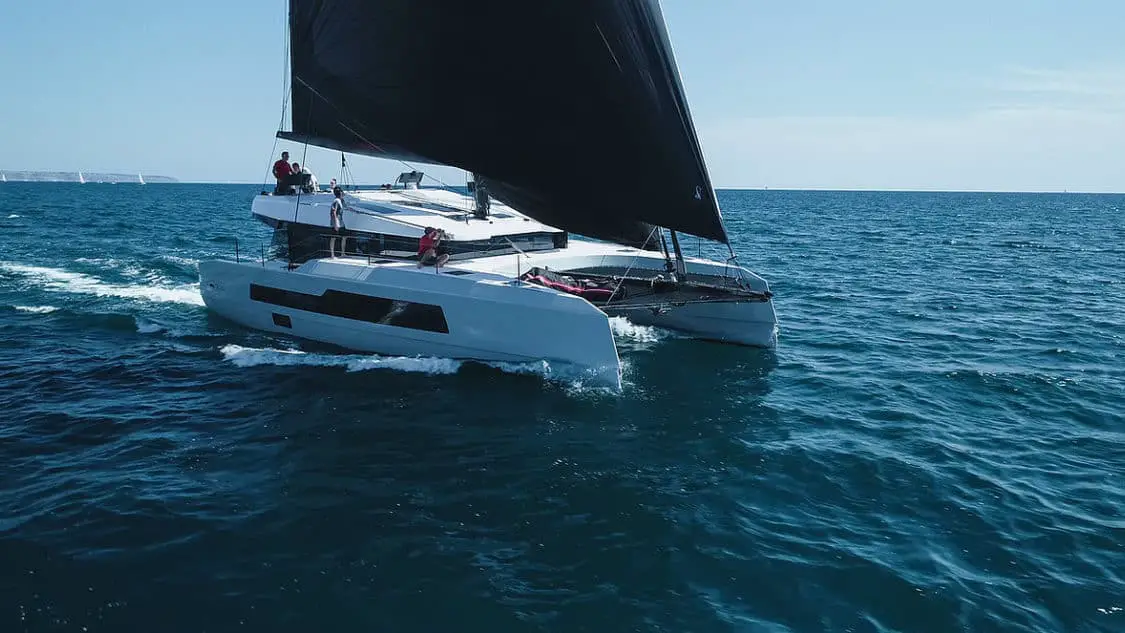
Performance Cruising Catamarans Have Narrow Hulls
Performance catamarans contain two small narrow hulls, which cause them to have less water resistance. Smaller hulls mean the vessels have much smaller bow waves to fight, allowing them to move extremely fast. In addition, the less hull area is underwater, the faster the boat is capable of moving since there’s less drag.
Having said that, it’s important to note that a narrow hull is more prone to burying its bows in rough seas. The wider the hull, the more buoyancy it offers, but only up to a given point. After which, the excessive width becomes unmanageable and performance suffers. The key lies in finding the right balance.
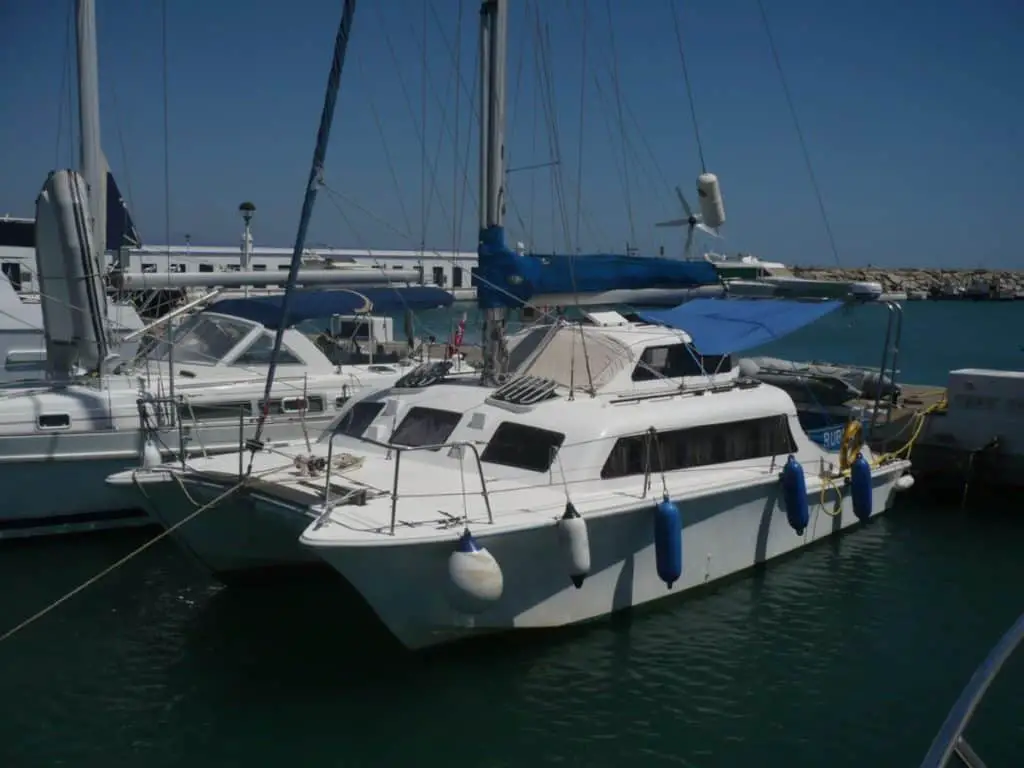
Performance Cruising Catamarans Have Considerable Length
The longer a cruising cat is, the faster it’ll move. While each vessel bears a maximum hull speed, in most cases, the lengthier the boat, the higher the speed it can reach. The length of the hull (length on the waterline) also has a significant impact on the speed performance. Thus, the cat attains maximum speeds when the wavelength is equal to the length on the waterline (hull speed).
Therefore, the longer the length of the hull, the better the performance of a high-speed cruising cat. You can also compare two cruising cats’ speeds based on this measure.
Performance Cruising Catamarans Have Quality Builds
Modern cat manufacturers continue designing more innovative high-performance cruising cats that deliver a new blend of performance and cruising features. They achieve this by using advanced construction materials, better daggerboard designs, and creative weight allocation. They also keep a keener focus on onboard amenities. For instance, asymmetrical daggerboards placed midships in each hull can help achieve proper balance and hull trim.
The overall goal is to design cruising cats that offer high speeds, outstanding performance, and enough offshore comfort.
Here’s an article if you are wondering what daggerboards and centerboards are and why they impact performance so much.
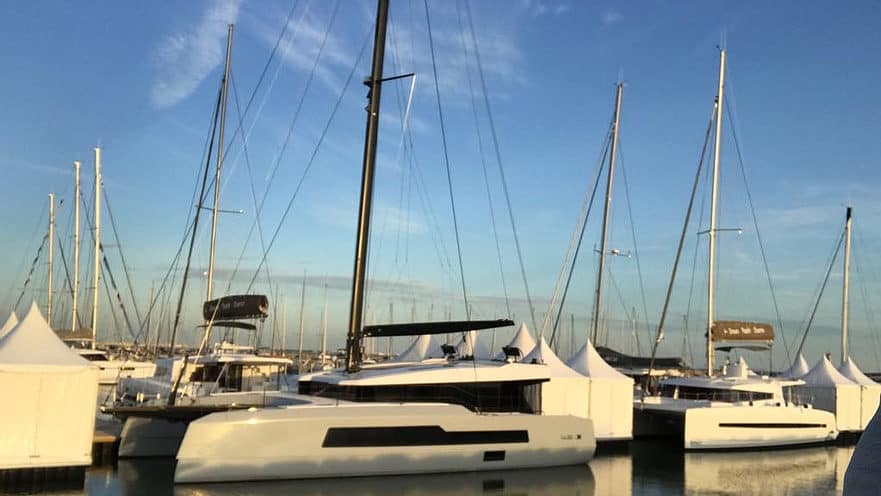
Performance Cruising Catamarans Are Light-weight
The lighter a cruising catamaran, the greater its performance. And some of the most popular high-performance catamarans find an optimal balance between performance and comfort. As a result, modern performance-based cruising cats have embraced the use of carbon composite construction for hulls, daggerboards, and rigging, instead of the somewhat heavier glass fiber materials.
A weighed-down cat produces less speed, which means excess immersion of the hulls renders the boat sluggish . The hull submersion also reduces the bridge deck clearance, promoting uncomfortable hull slamming.
You won’t find much difference in top speed between performance catamarans bearing similar lengths because they all have displacement hulls and mostly sail to hull speed with occasional surfing. This means that under skilled hands, these cats should exhibit roughly the same performance. A cruising cat’s performance is also highly dependent on the state of the sea, wind direction, and speed, amongst many other factors.
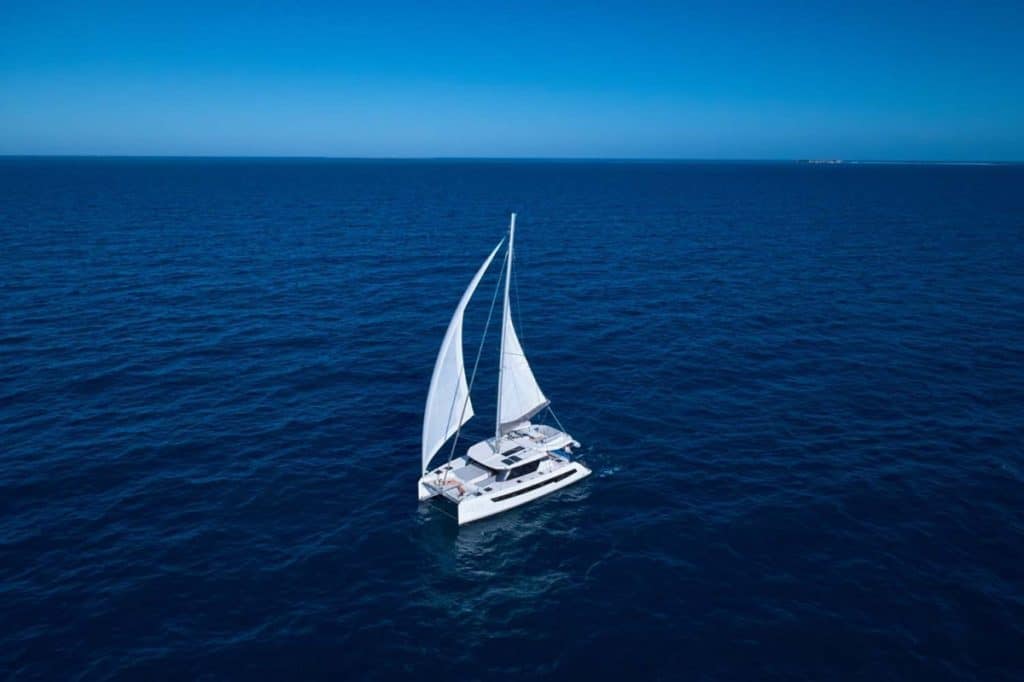
What To Consider When Choosing a Performance Cruising Catamaran
Speed is the number one consideration when choosing a high-speed cruising cat. Yet there are other factors just as important since they contribute to the overall cruising performance, including:
- What you’ll use the vessel for and where. Are you planning on doing coastal cruising or serious offshore cruising? Consider the number of people that you’ll be sailing with and the activities you’ll engage in. This also helps determine the size catamaran you’ll need.
- Comfort. While some racing enthusiasts might prefer spartan accommodation plans, most enjoy relative comfort on the high seas. In any case, modern high-speed cruising cats are designed to provide a certain level of creature comforts. And since most performance cats are custom-made, new boat owners may decide precisely which features to include in their cats.
- Quality. To produce light boats, builders employ the use of fine resins, carbon, epoxies, foam cores, and fiberglass. They build using a combination of vacuum-bagged techniques, foam cores, foam composite bulkheads, and make furniture and cabinetry with cored sandwich construction .
- Livability. One cannot underrate the appeal of sailing in a vessel with no heeling, not to mention the high privacy attained from separate living and sleeping areas. Panoramic views and exceptional deck space for lounging and entertaining are also essential in ensuring maximum cruising comfort. Fortunately, most high-speed cruising cats offer all these features and more.
- Equipment. Sailing upwind is a challenge for cruising cats since they tend to make lots of leeway. To make things easier, high-speed cruising cats come equipped with bigger rigs and either daggerboards or centerboards. However, this also means skilled sailors are required to operate them.
- Cost. Catamarans are generally expensive, but a cat built with longer, leaner hulls and less costly materials can still give an outstanding performance. Such materials include foam cores, epoxy bulkheads, and epoxy resins. Furthermore, it’s not necessary to use only carbon to build a lightweight boat.
Final Thoughts
Performance cruising catamarans are built using exotic, high-tech, lightweight materials to deliver an electrifying sailing experience. And as we’ve seen from the above list, these boats deliver performance plus much more. They’re not only speed cruisers, but they also provide a smooth, comfortable, and enjoyable cruising experience.
So, whichever option you go for – from the luxurious Gunboat 62 to the much more affordable Nautitech 44 – you’re sure to get a boat that suits your needs.
- Wikipedia: Spinnaker
- Wikipedia: High-Performance Sailing
- Yachting World: Fountaine Pajot Elba 45 Review
- Aeroyacht: Catamaran Speed
- Cruiser’s Forum: Nautitech 44…
- Nautitech Catamarans: Nautitech
- Katamarans: Marsaudon Composites ORC50 (TS5) Review
- Outremer USA: New Outremer 4x Performance Catamaran
- Dutoit Yacht Design: Balance 526 Review
- Go Downsize: How Fast Do Catamarans Go?
- Catamaran Guru: The Cruising Catamaran Performance Debate
- The Boat App: The Fastest Cruising Catamarans of 2020
- Sail Magazine: Performance Cruising Cats Set New Standards in Sailing Speed
- Cruisers Forum: Fast Cruising Catamarans – How Fast?
- Lagoon – Inside: The Secrets of a Catamaran’s Performance
- Sail Magazine: 10 Great Cruising Cats
- Cruising World: 40 Best Sailing Catamarans and Trimarans, Cruising Catamarans…
Owner of CatamaranFreedom.com. A minimalist that has lived in a caravan in Sweden, 35ft Monohull in the Bahamas, and right now in his self-built Van. He just started the next adventure, to circumnavigate the world on a Catamaran!
Leave a Reply Cancel reply
Your email address will not be published. Required fields are marked *
Save my name and email in this browser for the next time I comment.
Recent Posts
Must-Have Boat Gear for Catamaran Sailors!
Sailing is probably the most gear-intensive activity I've ever done; there are so many decisions to be made about what gear to buy now, for tomorrow, and what to definitely never buy. The gear on...
6 Best Trailerable Trimarans For Bluewater and Coastal Sailing
Having a boat costs a lot of money, even when you are not using it, marina fees, etc. And once it is in the water most sailors never go very far from their "home marina" and sailing will be somewhat...
- 2024 BOAT BUYERS GUIDE
- Email Newsletters
- Boat of the Year
- 2024 Freshwater Boat and Gear Buyers Guide
- 2024 Boat Buyers Guide
- 2024 Water Sports Boat Buyers Guide
- 2023 Pontoon Boat Buyers Guide
- Cruising Boats
- Pontoon Boats
- Fishing Boats
- Personal Watercraft
- Water Sports
- Boat Walkthroughs
- What To Look For
- Best Marine Electronics & Technology
- Watersports Favorites Spring 2022
- Boating Lab
- Boating Safety

The Excitement of Running a P1 Offshore Race Boat
- By Charles Plueddeman
- November 16, 2023
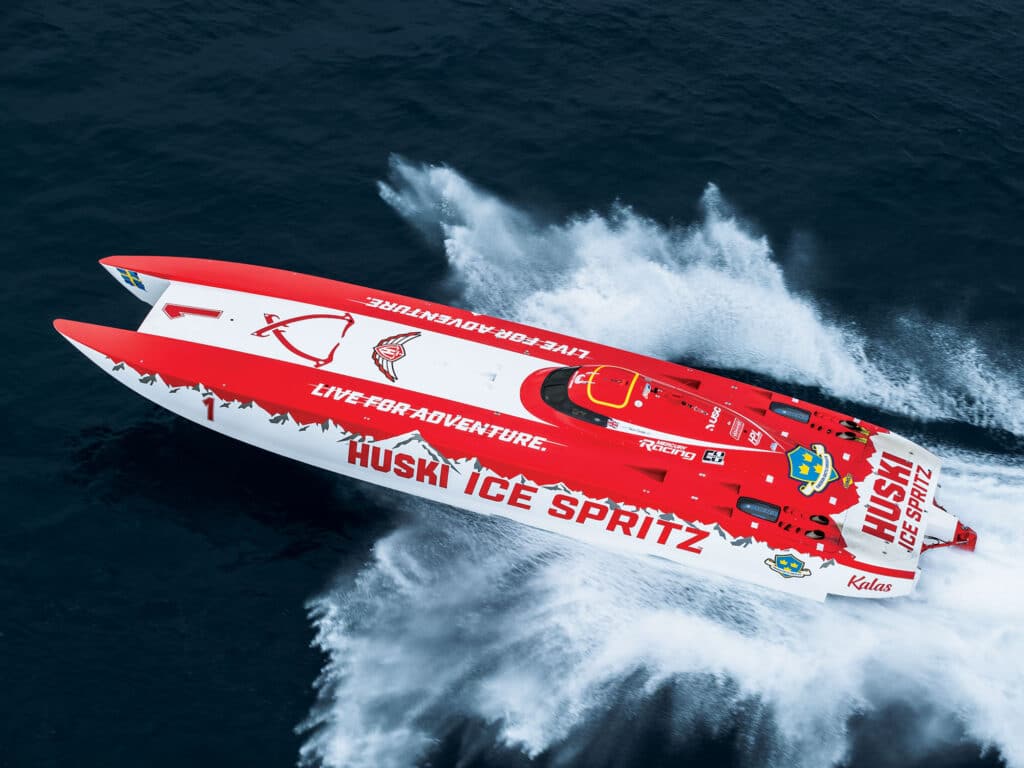
In this age of 70 mph pontoons , 90 mph center-consoles and 150 mph sport cats, it’s pretty easy to experience eye-popping velocity on the water. So, there you are, the wind flapping your cheeks as you hold that throttle to the stop, one watering eye on the speedo as you bump the trim hoping to squeeze out the last bit of speed it will take to be the first boat to the poker-run card pickup. Maybe you even imagine that’s Reggie Fountain , Steve Curtis or Shaun Torrente at the helm of the boat you are pursuing, and instead of a king of hearts, there’s a big trophy waiting at the finish line. Well, dream on, Speed Racer. You’re going fast, but you are not racing, and your production-built motorboat is no race boat.
Steve Curtis throttles a real race boat. The Victory catamaran Huski Chocolate carried Curtis and drivers Travis Pastrana and Brit Lilly to the 2022 UIM Class 1 championship in the Powerboat P1 Offshore series. Last summer, we met Curtis and this boat, now rechristened Huski Ice Spritz, at the Mercury Racing Midwest Challenge in Sheboygan, Wisconsin, the fourth event on the five-race 2023 P1 schedule. The boat is owned by SVEA Racing Inc., based in Stuart, Florida, regarded as the benchmark in professionalism and experience in Class 1 and led by technical director Gary Stray, director of operations Scott Colton and crew chief Patrick Cleaveland.
Curtis, a 59-year-old Englishman and the son of Cougar Powerboats founder and racing catamaran innovator Clive Curtis, claimed his first Class 1 world championship in 1985 in Key West when he was 21 years old. In his career, Curtis has throttled more than 20 world champions. Who would be better to show us under the cowl of a Class 1 race boat than the acknowledged master of throttling racing cats?

Class 1 is the premier category of international offshore powerboat racing. A P1 Offshore event can include a number of classes, but only the Class 1 Championship is sanctioned by the UIM (Union Internationale Motonautique), the world governing body for all powerboating activities. Basic rules for Class 1 dictate a minimum boat length overall of 12 meters (about 39 feet) and a minimum weight of 5,400 kilograms (just over 11,900 pounds). There have been seven boats in the Class 1 field in 2023, ranging in length from the 43-foot Skater Monster Energy/MCON to the 51-foot Mystic dfYoung. The Huski Ice Spritz/SVEA Victory is 47 feet length overall, with a running surface of 41.5 feet, according to Curtis, and a 12-foot beam. Curtis explains that the bigger boats often have an advantage in rough conditions, but the smaller boats can be nimbler in a current on flatter water in a tight, multiturn closed course—the 5-mile course at Sheboygan had 10 turns.
“Courses have become smaller to make the event more spectator-friendly,” Curtis says. “We used to run 40-mile laps and 200-mile races.”
The age of the Class 1 fleet is also surprising. Huski Ice Spritz/SVEA was built in 2007 by the Victory team in Dubai to a Michael Peters design.
“The boat has been rebuilt and repowered a number of times,” Curtis says. “I believe it was originally powered by Lamborghini V-12 engines. The boat has been crashed and repaired. The entire deck has been replaced, and the running surface adjusted as the engine package has changed.”
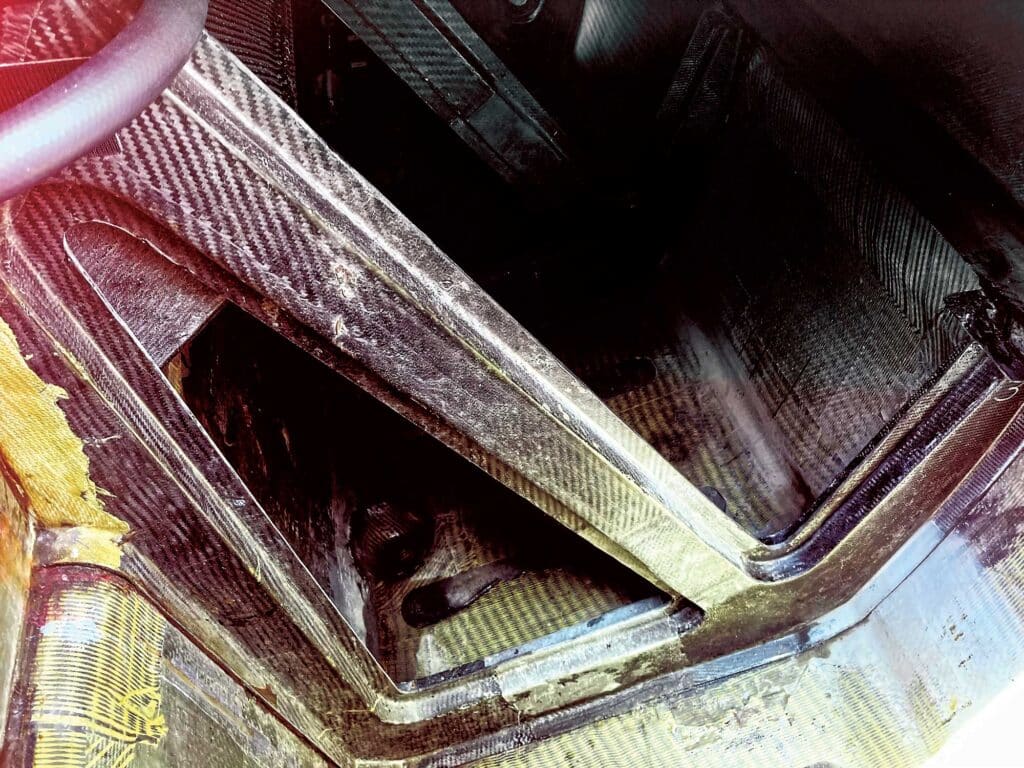
Carbon, Of Course
The overall theme of a race boat is that every element is functional, and this is the key difference between Huski Ice Spritz and your go-fast rig. Speed and safety are all that matter. The hull and deck are laid up with a combination of carbon fiber and Kevlar composite, with foam coring of various density. Bulkheads are carbon fiber, molded in a combination of triangulation and U-channel shape, and bonded within the hull. Each sponson has a pair of steps that are about 1.5 inches deep and a single strake. The tunnel between the sponsons is designed to trap and compress air, which lifts the boat at speed. The tunnel is about 33 inches deep at the bow but only 22 inches deep at the transom.
A V-hull boat could run in Class 1, but the catamaran offers a significant advantage, according to Randy Scism, who helped establish the Victory team as a force in offshore racing before returning to the United States in 1998 to start performance boatbuilder Marine Technologies Inc.
“A comparable V-hull boat will be 20 to 30 mph slower at top speed,” says Scism, who designed the 48-foot MTI Class 1 cat XInsurance/Good Boy Vodka. “In some conditions, it might corner better, but it could never make up the difference in total lap time. The air cushion under a cat can carry 30 to 35 percent of the boat’s weight, so the bottom is not even touching small waves and chop.”
Builders seek to produce a boat that is significantly below the class minimum-weight specification. This allows each team to make weight using lead ballast—water ballast is not allowed—that can be positioned right on the stringers to keep the center of gravity as low as possible to enhance handling and help trim the boat. Weight, either lead bars or bags of lead shot, can be placed aft to lift the bow in calm conditions or forward to hold the bow down in rough water. Fuel tanks are located directly on the boat’s center of balance so that balance does not change as fuel is consumed. At race venues, a crane fitted with a scale lifts the Class 1 boats from the trailer to the water; this way, each boat is weighed every time it goes in and comes out of the water to prevent cheating.
At Class 1 speeds, aerodynamics becomes critical. The boats literally fly over the water, and the deck is flush with the top of each sponson. The enclosed cockpit is a teardrop blister, hatch latches and cleats are carefully recessed and faired, and air intake is accomplished with low-drag NACA ducts. When conditions are ideal, these huge boats appear to levitate with a grace that belies the brutal thrust required to reach speeds that can exceed 160 mph on the open ocean.
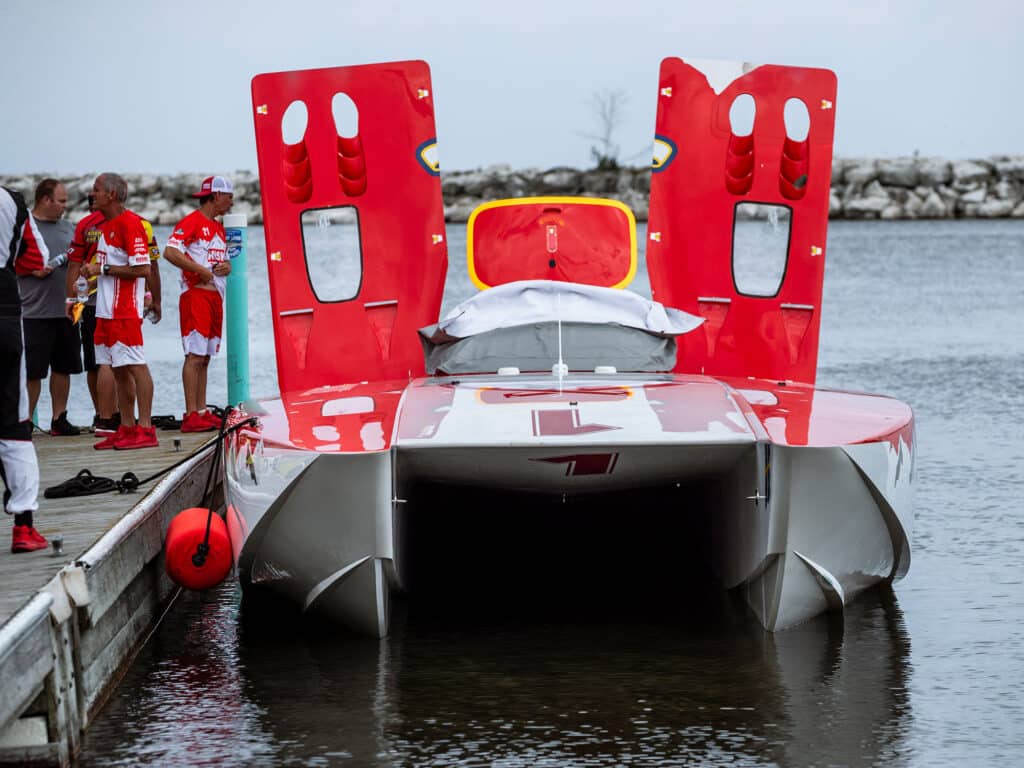
Prescribed Power
There are no surprises below the engine hatches of a Class 1 boat. Since P1 led a revival of the class in 2019, the Mercury Racing 1100 Competition engine has been standard power, a spec engine for the class. The 9.0-liter V-8 engine features Mercury Racing QC4 quad-valve cylinder heads and is boosted by twin turbochargers. Power output is 1,100 hp and 1,100 lb.-ft. of torque per engine on 93-octane pump gasoline. Each big V-8 turns 6,000 to 6,500 rpm. The transmission is the stout model designed for the Mercury Racing 1750 engine with a stronger input shaft and internal components.
“Before the switch to the Merc 1100, we were running engines making 1,850 to 2,000 hp at 7,500 rpm,” Curtis says, “and top speeds pushed 190 mph. Those engines needed a rebuild after each race.”
The point of a specified engine for the class is to reduce cost and ensure power parity among teams with unequal resources. With that in mind, the engines are tightly controlled. Teams are not allowed to make any adjustments or modifications to the engines. With the exception of the valve covers, the engines are sealed with special fasteners. At the beginning of each race weekend, the Mercury Racing support team delivers propulsion control modules (PCM) to each team. The PCM units are painted bright yellow so they are easy to identify. Mercury Racing also installs a data logger on each engine.
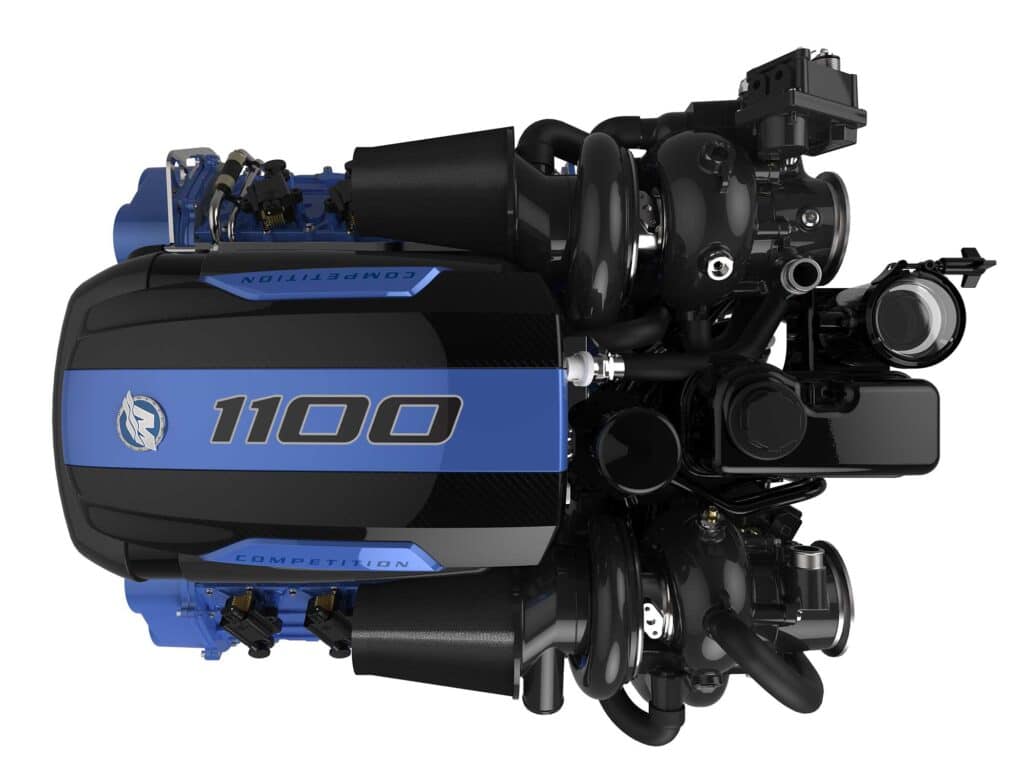
“After every practice and every race, we download the data to make sure it makes sense and that nobody has tweaked on the engines and turned the power up,” says Steve Wynveen, Mercury Racing manager of development engineering. “The idea of Class 1 now is that winning is dependent on driving and boat setup, not on who has the most money to throw at an engine.”
The expectation is that if teams don’t abuse these engines by constantly banging into the rev limiter, each can last the season with just basic maintenance. Teams will put between two and three hours of run time on the engines at each race weekend. Teams are free to install their own PCM for testing between races.
The Huski Ice Spritz/SVEA team engineered a number of quick-disconnect fittings that allow it to remove an engine in about 20 minutes, according to Curtis. This team pulls its engines after each race for maintenance and inspects the bilge and engine mounts below the engines. Typical maintenance includes an oil and filter change, checking the valve lash and adjusting with shims, a compression and leak-down test, checking the turbocharger waste-gate adjustment, and torquing all fasteners and clamps.
Six of the boats in this Class 1 fleet use surface drives based on a BPM model to put power to the water. The Italian drive only articulates in the vertical plane, which provides a limited range of trim, generally less than 15 degrees or, according to Curtis, about 1.5 inches at the propeller. The prop is located about 58 inches abaft the transom. A drop box located on the exterior of the transom allows teams to quickly change gear ratios to best match engine torque to the prevailing conditions. Curtis explains that on today’s short courses, acceleration out of turns is often more important than top speed. Teams using a surface drive are limited to three prop sets but have unlimited gear ratios. Steering is accomplished by a center-mounted rudder—a knife-sharp polished stainless Italian Flexitab model on Huski Ice Spritz—and teams can change rudders based on water conditions.
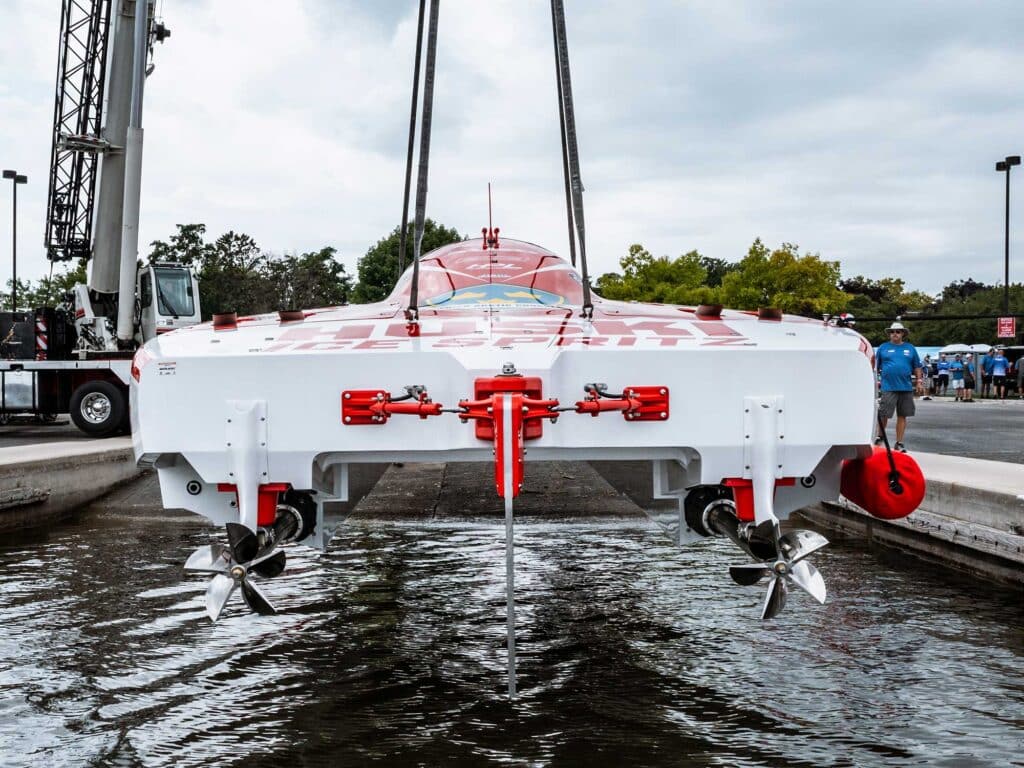
A sterndrive is also permitted in Class 1, but if the sterndrive can steer, the boat is not allowed to use a rudder. The MTI XInsurance/Good Boy Vodka boat is rigged with modified Mercury Racing M6 sterndrives. Trim is retained, but the skegs are cut off and steering is locked. The boat is equipped with a rudder. Teams running sterndrives are allowed an unlimited number of propellers.
“The problem with trying to steer these boats with the sterndrives is that when you turn the drive, one prop is pushed into water and the other into the air coming through the tunnel,” Scism says. “The prop in the air loses thrust. You want to keep both props centered behind the sponsons. I prefer to use the M6 drives for the added trim authority. That drive is plenty rugged for these engines.”
Read Next: How to Boat Safely at Any Speed
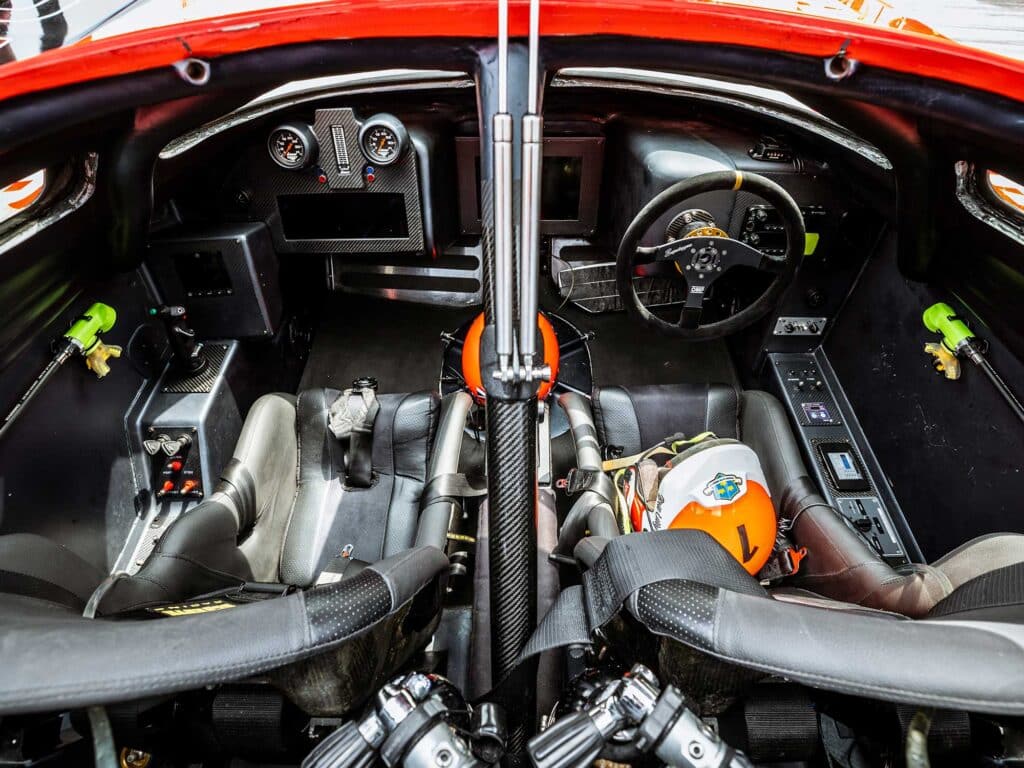
Curtis throttles with his right hand gripping a pair of Mercury Zero Effort controls topped with red plastic knobs molded to the shape of his hand. To his left is a fixed, molded grip with radio/intercom control buttons, trim control, and a button to change the screen display. Curtis can communicate with his team using VHF and UHF radios, and a cellular connection. Below is a pair of Mercury ignition keys, which we were surprised to see.
“When we went to the standard Merc 1100 engines, we wanted to retain the entire stock wiring harness to prevent any sort of tampering,” Curtis says. “So, there are the keys, just like on your fishing boat. It was the easiest solution.”
Facing Curtis are a pair of Livorsi turbocharger boost gauges, a Livorsi trim indicator, and a multifunction display usually showing tachometers. In the center of the dash is a Garmin MFD split between navigation and a rearview camera. The driver sits before a quick-release steering wheel with a lap counter on top of the dash, which will also display a yellow-and-red flag signal from race control.
I wish I could describe the sensation of driving Huski Ice Spritz at speed while looking through the slit of a windscreen. But as it turns out, there is not enough liability coverage or legal cover to ever make that happen. Scism says MTI will build you a new 48 Race model to Class 1 specs, with a price tag of $2.2 million to $2.4 million with power. A $500,000 budget will cover a bare-bones Class 1 team for a season, Curtis says, with a well-financed team spending more than $1.5 million. SVEA Racing Inc. brings a crew of 10 to each race with a 70-foot race trailer, a tilting boat trailer and its Kenworth hauler, and a world-champion throttleman. They are not going to a poker run.
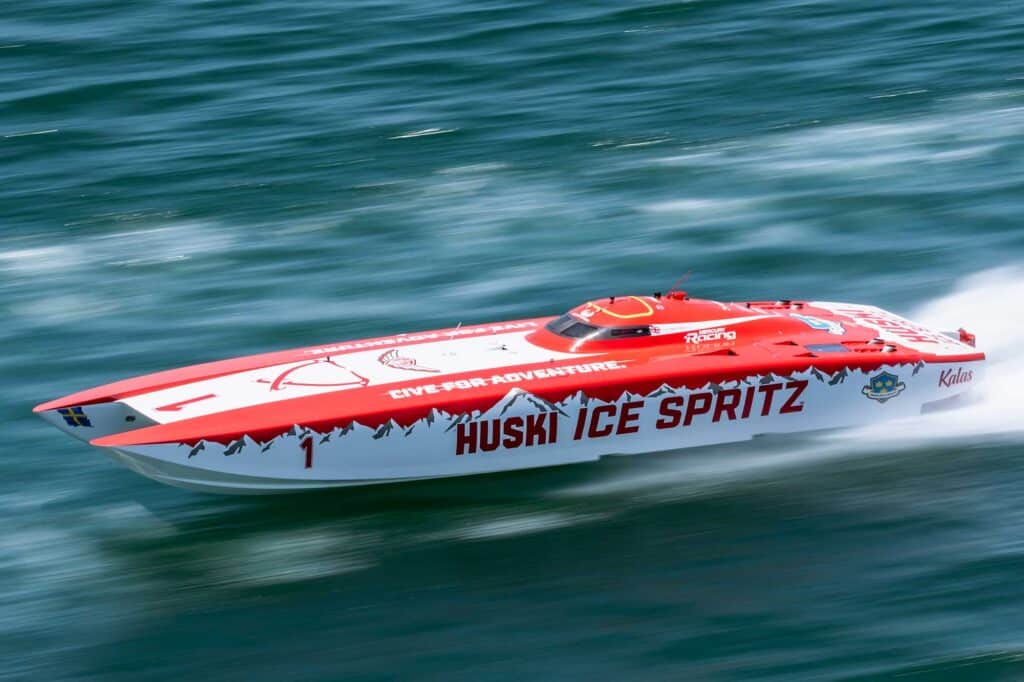
Safety First
When Steve Curtis won his first Class 1 championship, he was standing in an open cockpit. “There was very little concern for safety in those boats,” Curtis says. “If you stuffed the boat, it was very likely you’d be killed.”
Today the driver and throttle work in an enclosed cockpit that is all business. This is not your pleasure boat—there is no Alcantara upholstery, no bass-pumping audio system, and no LED-illuminated drink holders. Cockpit entry is through a hatch secured with four sliding bolts like a bank vault. In Huski Ice Spritz, Curtis throttles from the port seat, and the driver is at the wheel to starboard. Deep bucket seats have 2 inches of suspension travel, and the crew is strapped securely in place. “During a race, it can actually get rather violent in here,” Curtis says. “It’s not very noisy, but there is a lot of vibration, even in smooth water, because the boat is so rigid. We can feel pretty beat up after a race.”
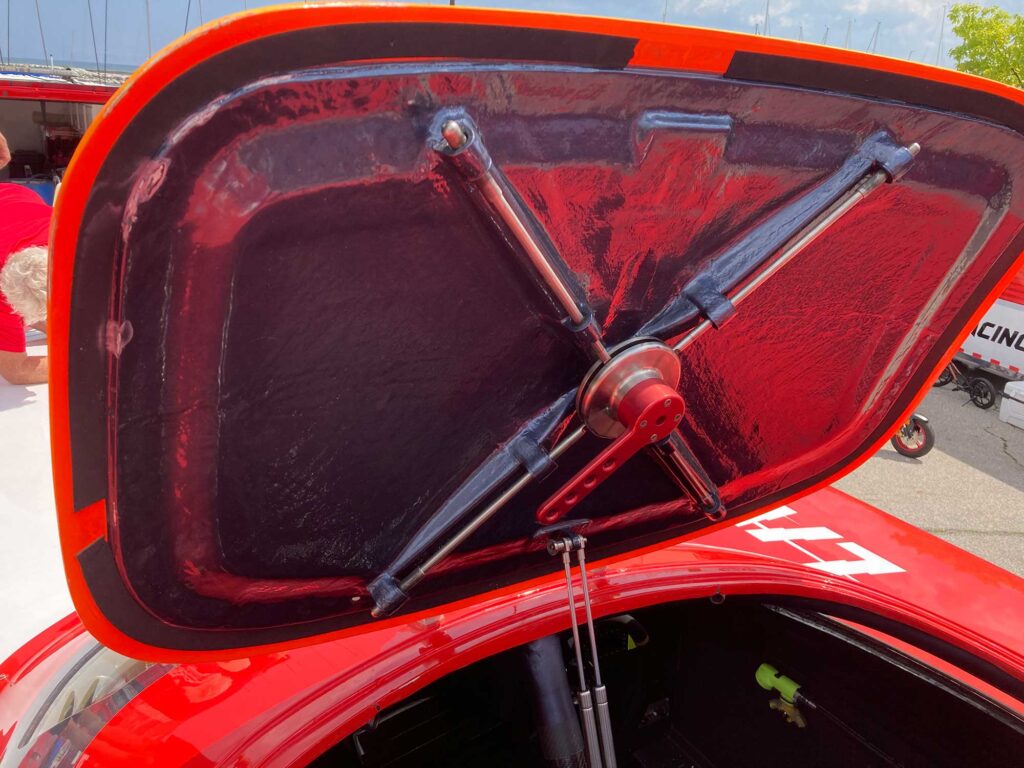
A cage of carbon channels surrounds the cockpit, which Curtis says is backed by a very thick bulkhead. Crush zones around the cockpit are designed to absorb energy on impact. The interior is raw and black, with no thought of cosmetics. The forward portion of the cockpit structure is formed by a ¾-inch-thick polycarbonate shield modeled after a fighter-jet canopy. The clear portion is minimized for further crew protection. There’s an emergency escape hatch in the floor for egress if the boat flips. The driver and throttle have a 10-minute emergency air supply.
- More: Performance Boats
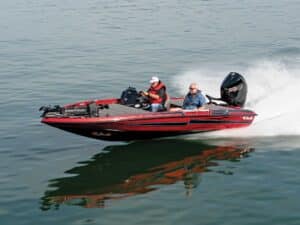
Boat Test: 2024 Bass Cat Caracal STS
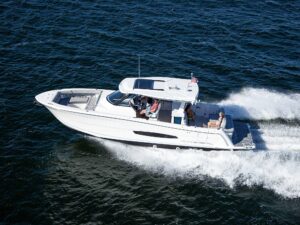

Boat Test: 2024 Regal 38 Surf
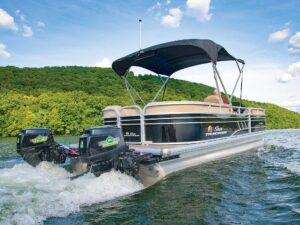
Using Hydrofoils to Improve Boat Performance
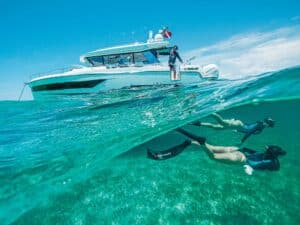
Six Boats Built for Adventure
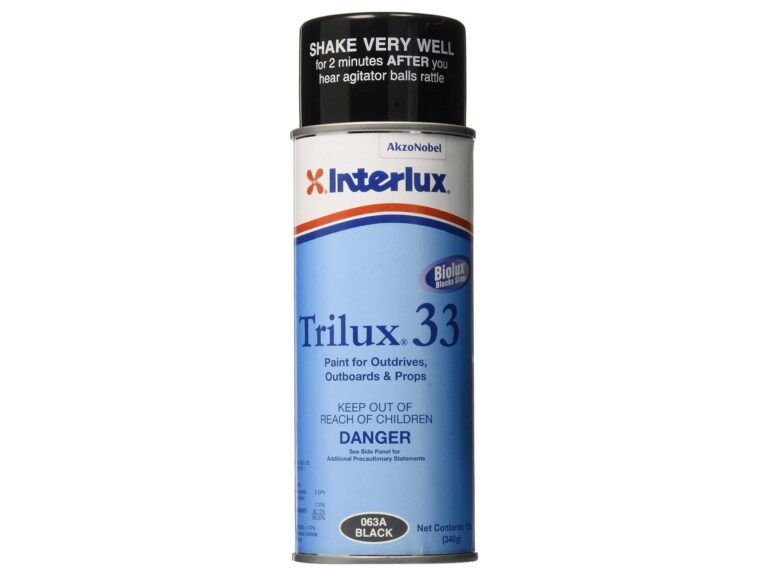
We Test Interlux Trilux 33 Aerosol Antifouling Paint

Boating Shoes for Spring and Summer

MasterCraft Celebrates International Women’s Day With Fourth Annual ‘Let Her Rip’ Campaign
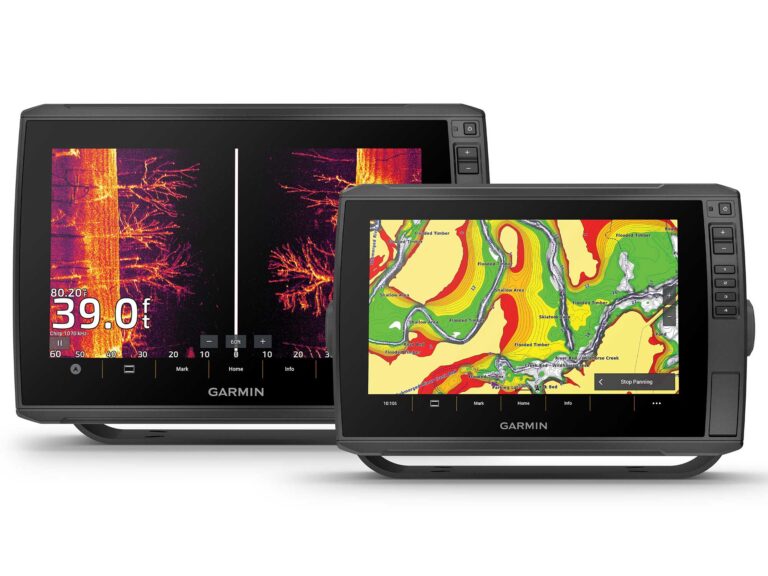
Garmin EchoMap Ultra 2 Series

- Digital Edition
- Customer Service
- Privacy Policy
- Cruising World
- Sailing World
- Salt Water Sportsman
- Sport Fishing
- Wakeboarding
Many products featured on this site were editorially chosen. Boating may receive financial compensation for products purchased through this site.
Copyright © 2024 Boating Firecrown . All rights reserved. Reproduction in whole or in part without permission is prohibited.

My Cruiser Life Magazine
Fastest Catamarans for Cruising in 2023
Catamarans appeal to sailors and would-be sailors for a variety of reasons. One of those reasons is the need for speed—cats have a reputation for being faster. There are dozens of brands and tons of great boat designs that capitalize on this, and designers are constantly pushing the bounds and asking, “Really, how fast can a catamaran go?”
Performance sailing catamarans may look like your run-of-the-mill Leopard or Lagoon from a distance. But these boats are full of little tricks to boost their speeds—narrow hull designs, retractable daggerboards instead of keels, and extensive use of cutting-edge lightweight materials like carbon fiber. All of this adds up, so expect to pay double, triple, or maybe much more for a truly fast catamaran. And that means there are far fewer boats on the water, and owning one puts you in an exclusive club.
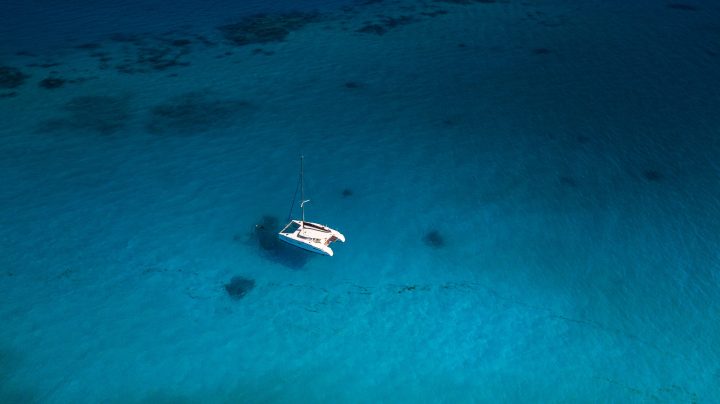
Table of Contents
Neel trimarans, what is a fast catamaran, how fast can a catamaran go, are fast catamarans the boat you’re looking for, fast catamarans faqs, top brands of fast catamarans.
Here’s a list of some of the best-known and trail-blazing fast catamaran makers. These companies are making luxury performance catamarans suited for owners who want to cruise fast. These aren’t barebones race boats built for nothing but speed. Instead, these are comfortable boats that will outperform most others in their class.
Most performance boats will be 45 feet long or more. Small catamarans don’t fall into this category, and most production liveaboard catamarans are built too heavily in order to save money.
For more than two decades, Gunboat has been setting the bar on what a performance catamaran can be. They took state-of-the-art technologies from the racing world and applied them to family-friendly cruising catamarans. The company started in the US in 2002. One of the company’s stated missions is to create boats that sail faster than the wind in anything more than 6 knots of breeze.
Since 2016, Gunboat has built top-quality boats at their La Grande-Motte, France, facility. However, they are still a boutique builder making only a handful of boats yearly. Their current offerings include the 68, 72, and 80. All boats have narrow hulls, retractable boards, high-performance sail plans, carbon fiber construction, and luxurious living accommodations.
The first hull of the Gunboat 68, CONDOR, was launched in 2019 and set out on a trans-Atlantic crossing immediately after its sea trials. The crew wrote a detailed report of the experience and the boat’s performance. CONDOR exceeded 30 knots occasionally, but average speeds were between 14 and 17 knots. Their best 24 hours saw 328 nm (an average speed of 13.7 knots).
The company motto says it all. “Life is too short to sail a slow boat.”
Outremer Catamarans is one of the original makers of French performance cats, in business since 1984. According to their website, the company has made over 300 boats since then. A large-scale production boat maker they are not. These are custom-built fast catamarans of the highest quality, made for safety, comfort, and speed. Outremer recently received much attention when popular YouTubers Sailing La Vagabonde sailed aboard an Outremer 45 for several years.
Currently, Outremer offers boats ranging from the 45 to the 5X (48 to 60 feet long). The X models (4X and 5X) are even more performance-oriented, with more extensive use of carbon fiber and a more race-inspired sail plan.
View this post on Instagram A post shared by Riley Whitelum (@riley.whitelum)
Catana is yet another French performance brand of luxury cruising catamaran. Today, Catana Group also makes Bali cruising catamarans, effectively marketing Catanas to the performance set and Bali’s to the cruising and charter set. https://www.catana.com
Presently, Catana is only making two models, the OC50 and the 53. Historically, however, Catana has made many beautiful boats. Notably, the 471 is a fast cruising catamaran that is a favorite among long-distance cruisers. On the smaller side, the 431 and even the 401 and 381 are quick and fun sailers that move better than their competition.
Catanas are easily recognizable by their daggerboards and narrow hulls with asymmetrical designs. In addition, they use a lightweight composite layup that results in a very stiff boat that weighs less than their competitors. Still, Catanas are not on the same level as an Outremer 5X or Gunboat–these are fiberglass boats that are built better than the competition and made to outperform many other boats.
HH Catamarans is Gunboat’s first real competitor in the high-end performance cat market. They started in 2012 and are part of the Hudson Yacht Group. The boats are designed by Morrelli & Melvin, a highly-regarded multihull design firm, and are built in Xiamen, China, or Cebu, Philippines.
HH has boats in their model line from 44 to 88 feet long. The company focuses on providing what owners and sailors want and are looking for, so you’ll see lots of customizability within the lineup. They include features you won’t find from a lot of builders, including lots of planned real estate for solar panels (5kW or more!), hybrid drive systems, and ocean cruising OC (keels) or sport cruising SC (daggerboard) models to pick from.
View this post on Instagram A post shared by HH Catamarans (@hh.catamarans)
Balance started in South Africa in 2013. They focus on making semi-custom, comfortable performance yachts that are strong and safe and can be easily operated single-handedly or by a couple. They are live-aboard boats that strike a balance between comfort and performance. But, compared to the current offerings from Lagoon or Leopard, it’s clear that Balance cats skew far more toward performance than others do.
Models currently range from the 442 to the 750. They’re available with daggerboards or keels and made with extensive carbon fiber and all epoxy-resin composites. According to their website, the current record speed for a Balance 482 while surfing is 28 knots. She’ll cruise all day between 8 and 14 on a reach, though. They describe the 482 as a “trend-setting circumnavigator”—the perfect boat for your sail around the world route .
Kinetic Catamarans are designed by Simonis Voogd and built in Knysna, South Africa. Like others on the list, these are semi-custom, luxury, performance cruising cats with an emphasis on speed. They have all-carbon construction, carbon spars, laminated sails, and a forward sailing cockpit deck layout.
Since they are truly semi-custom, each boat is spec-ed out to each buyer’s vision. This includes standard or racing rigs, centerboards or daggerboards, and many furnishings, layouts, and outfitting options. Kinetic currently offers 54 and 62-foot versions.
What’s better than two hulls? Three, maybe. That is, three might be better if your goal is truly fast sailing. Neel Trimarans is a new French builder attempting to capitalize on this simple fact by merging the best of all worlds—the space and liveability of a cruising catamaran with the performance, sail efficiency, and stability of an offshore-capable tri.
The company presently offers models between 43 and 65 feet. They say cruising speeds are reliably over 10 knots, with 15 to 18 knots when the breeze freshens. Compared to cats, these boats’ rigid central hulls allow for stronger rigging and better upwind performance, and the central keel allows better tracking and rudder control.
Now you’ve looked at some fast cats, you might wonder what constitutes “fast.”
You will be wowed if you’re selling your 30-foot monohull and moving up to a 50-foot cat. But if you’re coming from the world of car and plane travel, sailboats of any ilk are anything but “fast.”
The first thing to accept is that all sailboats are slow . This shocks many people who think they’d like to travel and see the world by sailboat. The marketing of these “fast cats” is everywhere, and the idea that the faster boat is safer because you can “beat the weather” is especially pervasive. No sailboat at sea can outrun a front or storm cell moving at 30 or 40 knots.
In truth, the fastest catamaran you can comfortably live aboard and cruise on will average out under 15 knots . In similar conditions, production catamarans might be doing 10 to 12. The monohull speeds of the same length might be 7 or 8 knots, and a bigger monohull with similar living space might be doing 10 or 12.
So don’t be lulled or wowed by these vessel’s maximum speed or “surfing” claims—they’re fun numbers to kick around with your dock neighbors, but what really matters is how many miles you can tick off in a day of travel.
To get more speed than this, you’ll either push the boat in ways that are not safe or comfortable at sea, or you will have to find bigger, more advanced, and even more expensive vessels. Most boats on this list are luxury liveaboard that is safe to travel the world.
But are they fast? As the old sailor saying goes, “Nothing goes to weather like a 747.” Sailing is still sailing. And sailing is a slow, slow, slow way to see the world.
Traditional monohull sailboats are displacement vessels that are limited by a few rules. As they push the water out of their way, they build up bow and stern waves. Push too much water, and the waves get bigger, pulling the vessel farther into the water. So no matter how you power it, it’s limited to hull speed. Hull speed is a factor of waterline length, width of the hull, and displacement.
Modern designs favor flat bottoms like powerboats, with the idea that they can surf and plane to get more speed. Catamarans take this even further, and with some clever design tricks , it’s possible to get a catamaran well above displacement speeds for extended runs. Of course, a lot depends on the hull type, and other factors are also at play.
Catamarans are very sensitive to weight . Their speed comes from being a lightweight boat with the ability to fly across the water, contrary to how a heavy monohull plows through it. The heavier the boat, the lower it sits in the water.
Therefore, adding weight to any catamaran will slow it down. To this end, finding a performance-oriented liveaboard catamaran less than 47 feet long is difficult. Less than this, and the narrow hulls simply can’t hold the weight of you and your stuff.
Finally, there’s the consideration of the environment you’re sailing in. The wind is obvious—they sail fastest on a broad reach. And, just like any other type of boat, they are slowest when close-hauled and on a run.
Rough seas are another of the catamaran characteristics to consider in your need for speed. Often the boat is capable of more, but the ride is rough and uncomfortable.
So you shorten sail and slow down to find the sweet spot of comfortable sailing speed—enough power to maintain a good speed without pounding your brains out and causing undo fatigue on the crew. And, of course, the rougher the conditions, the slower the boat’s performance as she slows and in the troughs and speeds “downhill.”
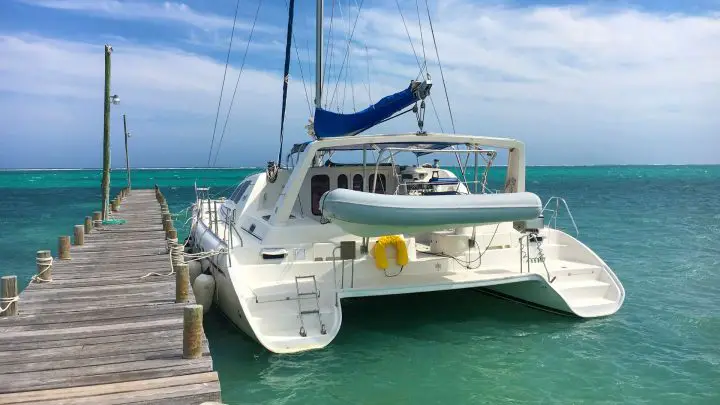
While they are faster than other vessels, that’s certainly not the only thing catamarans have going for them. Fast is a relative term, and “fast” sailing is still awfully slow. So unless you already love sailing, sailing fast might not have as much appeal as you’d expect.
Catamarans are great vessels with a lot of pluses. And these fast modern catamarans are some of the best—luxurious living space aboard comfortable, top-quality vessels.
What are the fastest catamarans?
Like those used in recent America’s Cup races, pure racing catamarans use foils to lift their hulls out of the water. Whether performance-oriented or not, regular catamarans for cruising are much slower, averaging between 10 and 15 knots. Still, they generally outperform monohull sailboats of similar lengths in most conditions, especially when sailing downwind.
How fast does a 50 foot catamaran sail?
There are many designs of catamarans, and they all sail differently. In some conditions, a pure racing catamaran may sail significantly faster than the wind speed. Most cruising catamarans, whether designated as “performance” or not, will max out around 12 to 15 knots. Momentary peak speeds may be significantly higher.
What is the fastest point of sail catamaran?
As with all sailboats, the fastest point of sail will be near a beam reach, where the apparent wind is 90 degrees from the boat’s bow. Since cats travel faster over the water, this usually means that the true wind is off the quarter, with a true wind angle of about 120 degrees off the bow.
How fast is the Gunboat 68?
Gunboat 68, hull number 1 (68-01), was launched in 2019. Immediately after sea trials, CONDOR crossed the Atlantic . The crew reported the vessel’s max speed exceeded 30 knots occasionally, with averages between 14 and 17 knots. Their best day was 328 nm, making the average speed for those 24 hours 13.7 knots (15.8 mph).
Matt has been boating around Florida for over 25 years in everything from small powerboats to large cruising catamarans. He currently lives aboard a 38-foot Cabo Rico sailboat with his wife Lucy and adventure dog Chelsea. Together, they cruise between winters in The Bahamas and summers in the Chesapeake Bay.
Leave a comment
Your email address will not be published. Required fields are marked *
Save my name, email, and website in this browser for the next time I comment.
- In the News
- Speed On The Water Videos
- Racing Reports
- Countdown To The 2024 Miami International Boat Show
- Coverage Of The 2023 Lake Of The Ozarks Shootout
- Coverage From The 2023 Key West Poker Run And Offshore World Championships
- Image of the Week
- Safe Boating
- New Products
- Featured Boat
- Latest Projects
- Year in Review Print Magazine
- Subscriber Login/Logout
- Subscribe to SOTW Magazine
- Buy Single Digital Mag Issues
- Magazine Archives
- Magazine Features
- Events Calendar
- Advertising Information
- Article Plaques
- Industry Partners

Latest Mercury 450R-Powered Victory Cat Reaches 141 MPH
Between the many trips over the last two months to Lake Havasu, the Colorado River-fed waterway that borders Arizona and California, it’s clear that Victory Powerboats West is on a mission. A 140-plus-mph mission to be exact.
The team at Victory Powerboats West recently spent some time dialing in its latest Victory catamaran with twin Mercury Racing 450R engines and reached an impressive 141-mph top speed on Arizona’s Lake Havasu. Photo courtesy Dale Dondel
Almost two weeks ago, I caught up with Dale Dondel, the owner of the Temecula, Calif.-based dealership for the new Victory Team -built outboard-powered catamarans. Dondel, who I interviewed four years ago when he took delivery of his new Eliminator Boats 28 Speedster with twin Mercury Racing Verado 400R engines ( read the story ), was pretty excited to talk about both the new Victory cats he’d recently tested on Lake Havasu.
One was his new demo model, an almost 36-footer dubbed the VTX 34 that is powered by twin Mercury Racing 450R engines and features a stellar paintjob. He had just run the boat, which did not have all of its finishing touches just yet, up to an impressive 140 mph and was raving about how well it performed and handled, and how fast it was with the 38-inch-pitch Dewald propellers. The other was the almost 30-foot sport cat that Victory calls the VTX 27. Dondel had delivered the all-white boat—also powered by twin Mercury Racing 450R engines—to a client in Parker, Ariz., a couple of weeks earlier.
Then yesterday we connected again regarding last weekend’s trip back to the lake in the completed Victory where he was able to squeeze another mph out of the boat by reaching 141 mph with the engines turning 6450 rpm, and still on the rev-limiter, he said.
The first time I spoke with Dondel, an accomplished off-road racer who owns Racer Engineering in Murrieta, about his new boating venture was in January when Victory Team representative Ricky Maldonado was delivering one of the new catamarans. He was obviously excited, but he’s even more so now.
“All around, and I’m not saying this because I’m selling them, I think the Victory cat is the best one on the water—and I’ve driven them all,” Dondel said. “The team has spent so much time and money on technology and testing over the years, and it shows. I think the boat out turns, out accelerates, out top-ends anything else on the planet. That’s not to say that other companies aren’t building some great boats, it’s just that Victory is ahead of the game.”

Check out the slideshow above for more images of the first two models finished by Victory Powerboats West in Southern California. Photos courtesy Dale Dondel and Tom Leigh/ Tommy Gun Images
Dondel said he has three already sold boats on order that he’s hoping Victory is going to ship to him soon. Along with potential customers he’s already connected with, he anticipates a lot of interest once the time comes to give more demo rides.
“These boats are homeruns, they really are,” Dondel said. “They’re so performance-oriented and they’re so responsive. The power to weight ratio is unbelievable especially for how solid the boats feel. The bigger boat has zero transition, absolutely no porpoise, at any speed. The smaller boat has a little one around 45 to 55 mph but that’s fairly normal with a cat. The acceleration of both boats is just ridiculous. When I flew back to Dubai and met with Scot Gillman and test drove the boat, I knew I had to be involved with them.”
Related stories Sweers And Torrente Hit 135 MPH Dialing In 34 Victory Cat With Mercury 450R Engines FB Marine Group Scores Victories Victory Pleasure Catamaran Update: Sport Cats And More In Progress First 34-Foot Victory Pleasure Cat Sea Trials On Tampa Bay Ballough Splashes New 32-Foot Victory Raceboat New Eliminator 28 Speedster Tops 125 MPH With Twin Mercury Verado 400R Engines
Iowa-Based Owners Take Delivery Of Vibrant Mystic M4200
Mercury racing offering 300-hp-outboard-specific propeller.


How Fast Do Catamarans Go?

Last Updated by
Daniel Wade
August 30, 2022
Catamarans are known for their speed, and some vessels are fast enough to break world sailing speed records.
Catamarans can go between 15 and 30 knots, with the fastest achieving speeds well in excess of 60 knots. Sailing catamarans are sometimes twice as fast as monohulls and cut through the water with greater efficiency.
In this article, we’ll cover how fast catamarans can go based on factors such as size, sail area, and design category. Additionally, we’ll compare catamaran speeds to monohulls and trimarans and cover the reasons why multi-hull sailboats blow monohulls out of the water.
We sourced the information used in this article from sailing guides and hull speed calculations. Additionally, we sourced information directly from the manufacturers of common catamarans.
Table of contents
Catamaran Speed by Type
Catamaran design can be split into different categories. After all, different vessels are designed for different tasks, as speed isn’t always the most important design consideration.
The fastest type of catamaran is the ultralight racing catamaran. These vessels have extremely narrow hulls and a remarkable planing ability. They’re designed to pierce waves and often achieve speeds in excess of 45 knots or greater, depending on conditions.
The second fastest catamaran variety is the sport catamaran. Sport catamarans often include a fairly good level of creature comforts in the cabin. They’re technically hybrid designs, because they are envisioned as a combination between a racer and a cruiser. Sport catamarans can achieve 30 knots or greater.
Cruising catamarans are designed primarily for safety and comfort. They’re often used for long offshore passages, where speed is important, but comfort is king. Despite their accommodations, cruising catamarans can still achieve a respectable 15 to 20 knots of speed—sometimes 50% faster than similarly-equipped monohulls.
Why are Catamarans So Fast?
Catamarans are remarkable vessels that can achieve amazing speeds. As a result of their unconventional design, typical calculations for hull speed (such as those used for monohulls) don’t always apply.
But what makes catamarans so much faster than equivalent monohulls? The first and most obvious speedy design element are the hulls themselves.
Catamarans don’t have a deep keel or a centerboard. This is because the second hull acts as a stabilizing device, and it helps the vessel track straight. The lack of a keel reduces weight (and equally important). It also reduces drag.
Additionally, catamarans behave in strange ways while underway. The hulls have a tendency to rise out of the water further the faster they go. This further reduces drag and makes it easier for the vessel’s speed to climb once it starts to move.
One additional characteristic is how the vessel’s sails point relative to the wind. Catamarans keep their sails perpendicular to the wind, which allows them to harness energy more efficiently. This is because, at a perpendicular angle, less wind energy is lost by spillage over the edge of the sails.
Are Catamarans Faster than Monohulls?
Yes, catamarans are typically faster than monohulls. They’re also a lot more stable, as their spaced-out hulls provide better motion comfort in rough seas. Catamaran hulls are narrower than monohulls, which also reduces drag and increases speed.
Catamaran vs. Monohull Speeds
We know that catamarans are faster than monohulls in most situations. But how much faster are they? Here’s a table of hull speeds for monohulls, which is a useful reference when comparing speed. Hull speed isn’t the absolute fastest that a boat can go, but it’s a good practical estimate for understanding the hydrodynamic limitations of single-hull designs.
Hull speed calculations for catamarans are more complicated. This is because catamarans have a greater length-to-beam ratio. And due to their narrow hulls and open center, they aren’t affected by the same hydrodynamic drag forces that monohulls are limited by.
For example, a 55-foot monohull sailboat with a waterline length has a hull speed of 9.4 knots or 10.9 mph. Its actual speed could exceed that in the right conditions, but rarely by more than a few knots.
Compare that to an efficient 51-foot catamaran, which can easily achieve speeds in excess of 20 knots in reasonable winds. That’s more than double the hull speed of a monohull with a similar waterline length and proves that catamarans operate under a completely different set of rules.
Wave Piercing
One aspect of catamaran design that makes them superior speeders is their ability to pierce waves. Specially designed catamarans have minimal buoyancy at the bow, which allows them to slice through waves instead of going over them.
This increases the speed at which catamarans can cover the distance. Think about it—a boat going over a wave has to use more energy to reach the same destination, as the height of the wave almost makes the distance further.
It’s like walking over a hill or on flat ground—you’ll take more steps walking up and down the hill than in a straight flat line. Wave piercing catamarans enjoy better stability, and they ‘take the flat road’ to a greater extent than monohulls.
Do Catamarans Plane?
Planing is when a boat’s hull rises out of the water due to hydrodynamic lift. This increases speed and efficiency, as there’s less drag but sufficient contact for stability. It also reduces rolling, as the bow only contacts the taller portions of the waves.
Catamarans have planing characteristics, but they generally don’t plane as dramatically as powerboats. This is still worth noting, as catamarans are specifically designed to use the phenomenon of hydrodynamic lift to gain speed and efficiency.
You’ll visibly notice a catamaran’s hull rising out of the water as it increases in speed. Compare that to a displacement monohull design (such as a classical cruising sailboat with a deep keel), which won’t rise out of the water in any significant way.
Are Catamarans Faster than Trimarans?
A trimaran is a catamaran with an additional hull in the center. Trimarans are usually less common than catamarans, but they have some of the same design benefits as other multi-hull sailboats.
At first glance, it would seem logical that trimarans are slower than catamarans. After all, they have an extra hull in the center, which likely increases weight and drag. However, there are more important factors at play here.
Trimarans are almost universally faster than catamarans. This has to do with weight distribution. Trimarans center their weight over the middle hull, using the outer hulls primarily for stability. This allows them to reap the benefits of a catamaran while increasing the efficiency of the wind power it captures.
Fastest Catamarans
Catamarans are popular for racing. There are several world records held by catamarans and numerous production boats with especially impressive speed-to-size ratios. Here are a few of the fastest racing and production catamarans ever built.
Fastest Sailboat Ever—Vestas Sailrocket 2
The Vestas Sailrocket is a specialized racing boat designed only for speed. This incredible vessel is actually the fastest sailboat ever built—and no wonder it’s a catamaran. A monohull simply can’t achieve record-breaking speeds when put head-to-head with a lightweight multi-hull.
The vessel, which earned the world sailboat speed record in 2012, has a modest 150 to 235 square feet of sail. Nonetheless, it managed to achieve a remarkable top speed of 65.45 knots in only 25 knots of wind. That’s about 72 miles per hour—in a sailboat.
Soon, a team of Swiss engineers will release their own version designed to beat the 65-knot speed record. Their vessel, which is a hydrofoil, will attempt to hit an incredible target speed of about 80 knots.
Outremer Catamarans
But what about production catamarans? How do they stack up, and how fast can they go? French boat builder Outremer Catamarans builds some of the fastest production catamarans ever built. These are not specialty racing boats—in fact, they’re average-sized cruising catamarans.
Let’s use the larger Outremer 51 as an example. This high-end cruising cat is known for its almost outrageous speed capabilities. In ideal conditions, owners of the Outremer 51 have reported speeds exceeding 20 knots for extended periods.
That’s a production catamaran with speeds that rival 20th-century warships. With such a fast boat, the world’s oceans start to appear a lot smaller. Plus, the genius design of the Outremer 51 allows it to be crewed by just two people.
But how do Outremer catamarans achieve such high speeds? The secret is in precise engineering and hull design, along with a sail plan that’s perfectly catered to the vessel. The hulls are sleek and narrow and designed to cut through the water with minimal drag.
From the bow, the Outremer 51 hulls look paper-thin. They increase in width gradually, which eliminates areas of sudden drag. These narrow hulls evenly distribute the vessel’s 21,825-lb displacement. Its low-buoyancy bows reduce drag and blast through waves instead of riding over them.
Related Articles
I've personally had thousands of questions about sailing and sailboats over the years. As I learn and experience sailing, and the community, I share the answers that work and make sense to me, here on Life of Sailing.
by this author
Learn About Sailboats
Most Recent

What Does "Sailing By The Lee" Mean?
October 3, 2023

The Best Sailing Schools And Programs: Reviews & Ratings
September 26, 2023
Important Legal Info
Lifeofsailing.com is a participant in the Amazon Services LLC Associates Program, an affiliate advertising program designed to provide a means for sites to earn advertising fees by advertising and linking to Amazon. This site also participates in other affiliate programs and is compensated for referring traffic and business to these companies.
Similar Posts

Affordable Sailboats You Can Build at Home
September 13, 2023

Best Small Sailboat Ornaments
September 12, 2023

Discover the Magic of Hydrofoil Sailboats
December 11, 2023
Popular Posts

Best Liveaboard Catamaran Sailboats
December 28, 2023

Can a Novice Sail Around the World?
Elizabeth O'Malley
June 15, 2022

4 Best Electric Outboard Motors

How Long Did It Take The Vikings To Sail To England?

10 Best Sailboat Brands (And Why)
December 20, 2023

7 Best Places To Liveaboard A Sailboat
Get the best sailing content.
Top Rated Posts
Lifeofsailing.com is a participant in the Amazon Services LLC Associates Program, an affiliate advertising program designed to provide a means for sites to earn advertising fees by advertising and linking to Amazon. This site also participates in other affiliate programs and is compensated for referring traffic and business to these companies. (866) 342-SAIL
© 2024 Life of Sailing Email: [email protected] Address: 11816 Inwood Rd #3024 Dallas, TX 75244 Disclaimer Privacy Policy

How Fast Do Catamarans Go? 5 Examples (With Pictures)
A catamaran is generally more balanced on the water and can be faster than a multi-hull vessel.
Unless you compare them to foiling monohulls like the new America’s Cup boats that sail at over 50 knots, they are not recreational vessels.
In this article, we will look at how fast each type of catamaran will go.
Table of Contents
Here are the numbers before we dive into the details:
Average Speed For Sailing Catamarans
Catamarans can vary in size from 14 ft to over 100 ft. Catamarans can come in a wide variety of design types.
Sailing Catamarans have been attempting to make advancements over their mono-hulled counterparts.
These advancements include:
- Foils that assist with lifting the vessel out of the water.
- Stability advancements.
- Racers that can maintain their speed while out in the ocean.
3 Different Types of Sailing Catamarans:
1) sport catamarans.

One type of sailing catamaran is a sport catamaran, which is otherwise known as recreational. These are typically supposed to have a small crew and launch and land on beaches.
Sport catamarans do not normally have living quarters and are ideal for day trips. Resorts or other rental services often use these.
These can also be used for racing.
Sport vessels have been known to travel over 30 knots but can speed over 40 knots in the proper conditions.
2) Cruising Catamarans

Another type of sailing catamaran is a cruising catamaran. These often come with complete living accommodations, so they sacrifice speed over their sportier counterparts.
They can average between 9 and 10 knots, depending on the conditions. The top speed is typically around 15 knots.
It would be best if you were careful with catamarans that have living quarters. The more you weigh it down, the less speed you will have.
3) Racing Catamarans

The final type of sailing catamaran is an ocean racing catamaran.
These boats are large and can reach over 100 feet in length.
The top speed of this type of catamaran is around 45 knots.
Because of the prize money for entering these in races, much research goes into their advancement.
Average Speed Of Power Catamarans
Catamarans with power motors fill a different type of boating category.
These are commonly used when speed and smoothness are favored over space or capacity.
Because of their stability, catamarans are good vessels for combating seasickness as well as transportation. We have a separate article here with all you should know about catamarans and (how to overcome) seasickness .
On a commercial level, these can be used for ferries for both people and vehicles. They are used for short term travel, often to or from islands.
Like sailing catamarans, there are a few types of power catamarans.
1) Power Cruising Catamarans

Similar to sailing cruising catamarans, they also have power cruising catamarans. These also have living quarters and are stable while out on the water. The speed of these vessels highly depends on the motors equipped and the size of the boat itself.
Like passenger transport or ferries, catamarans have a high speed of about 40 to 70 miles per hour.
These are made to travel at great speeds to allow their commuters the shortest possible ride to their destination.
The military also utilizes power catamarans. They use power catamarans to transport military cargo. These ships are ideal because of their speed, holding capacity, and ability to venture into shallow ports.
2) Swath Catamarans

They also have small-waterplane-area twin-hull vessels. These are called SWATHs.
These differ from the average catamaran because they also have submarine-like hulls that stay completely under the water.
Due to the hulls being submerged, they are not normally affected by waves. These are used most often in the ocean as research vessels. They can also be used for certain types of yachts. Because of their stability, they are good vessels for furniture that will not require as much securing.
These often travel between 20 and 30 knots.
Some catamarans are designed for wave piercing. These are made to pierce through waves rather than sail over them, causing them to be faster. These can be used as passenger ferries, yachts, and military vessels as well.
3) Whitewater Catamarans

There are also recreational catamarans made for whitewater travel. These are sometimes called “cata-rafts.”
They are made using two inflatable hulls connected with a scaffold. These are lightweight and perfect for whitewater sports.
They are even able to be packed away in a backpack. They can take up to 20 minutes to assemble, including inflation.
They have high speeds on white water rivers and can be most compared to a canoe, kayak, whitewater raft, or other white water vessels.
Performance Characteristics Of Catamarans
Catamarans require four times the power to double their speed. A mono-hull vessel, however, would require eight times the power to double their speed.
This is because a Catamaran has less resistance in the water.
This is also good for conserving and using less energy.
Catamarans are also more stable in the water. This stability is effective at resisting heeling or capsizing. A multi-hull vessel would require four times the force to capsize as a similar-sized mono-hull vessel.
The general sailing in a catamaran is smoother and allows for activities that are not always possible on a mono-hull sailboat.
Are Catamarans Faster than Mono-Hull Vessels?
Because catamarans have less water resistance, they are generally faster than mono-hull vessels.
This is because their hulls are smaller, which means they have a smaller bow wave to fight.
A bow wave is a wave created by the displacement of water by the bow of a ship. After a certain speed, a boat has to start hauling itself over its own bow wave.
The larger hull a ship has, the larger its bow wave will be and the more power required to fight it.
Catamarans have two small and narrow hulls, so they do not have much of an issue with their bow wave. This is one reason they are usually faster than a similar-sized mono-hull vessel.
Catamarans can be between 20-30 percent faster than their monohull counterparts.
Issues with catamarans over mono-hulls are that they can take more time to turn.
How Is The Speed Measured?
Boats commonly measure speed using GPS tracking devices to measure distance traveled. Speed while sailing is measured in knots. A knot is one nautical mile per hour, which equals about 1.15 miles per hour.
How Fast Are Catamarans Compared To Other Boat Types?
- Sailing catamarans typically average about 10 knots.
- Pontoon boats average about 20 mph.
- A powerboat cruiser can average anywhere between 30 and 50 mph.
- Cigarette boats can even reach close to 90 mph in the proper conditions.
- Sailboats average between 6 and 12 mph depending on wind conditions. This includes mono-hull between 6 to 8 mph and catamarans and trimarans between 9 and 10mph
Two different factors can determine the speed of sailing ships:
1) The hull type as listed above.
Different hulls rest in the water more or less than other types. The less of the hull that is underwater, the faster it can go.
This is because the less of the hull in the water, the less drag created while sailing.
2) The length of the boat
The longer the boat, the faster it can go. Every boat has a maximum hull speed that cannot be exceeded unless the boat can plane on the water’s surface or be lifted on hydrofoils. For most boats, the longer the boat, the higher the maximum hull speed is.
Speed Vs. Comfort Considerations For Catamarans
If you are looking for a catamaran, you have a lot of options.
You can choose to prioritize speed or comfort.
After deciding to purchase a catamaran, the type of catamaran you should look at depends on where and what you are using it for.
You will want to make sure that you look at what type of water you will be traveling in, how many people you are traveling with on average, and what type of speed you hope to achieve.
One thing you will want to keep in mind before the purchase of a catamaran is storage. If you intend to store your boat in a marina, you are often charged for two slips due to the beam, or width, of a catamaran versus the standard mono-hull vessel.
Catamarans can be beneficial for those who get seasick because they offer a steadier ride and the ability to have more open air space. Because the living quarters are not inside the hull and under the water’s surface, you have more windows and visibility.
Both sailing and power catamarans are viable options. Also, sailing catamarans can come with back-up power engines for low winds or situations such as docking in a marina.
Catamarans that have twin engines can offer more control and precision than those on a mono-hull vessel. This is good for tight and busy areas or navigating marinas.
Overall, there are plenty of options for you, and they offer many benefits over their mono-hull counterparts.
Click to share...

IMAGES
VIDEO
COMMENTS
Editor's note: "MTI At 25" is a new weekly series on speedonthewater.com celebrating the company's 25th anniversary. A new installment will go live every Wednesday on speedonthewater.com through the end of the year. Few if any high-performance theme-boats have stood the test of time better than Speed Racer, a 44-foot MTI catamaran built ...
Gunboat 68 (+35Kts) Gunboat 68 is a cruising catamaran designed to reach the highest speeds possible. Made by Gunboat, the ship uses Grand-Prix racing boats' designs to develop the speediest cruising catamaran on the market. Gunboat 68 is made entirely from carbon composites, which keeps the ship lightweight and fast.
Speed Racer was an absolute blast to drive through a sweeping turn at 95 mph. In fact the only time the catamaran was less than pleasant to drive was at 30 to 40 mph behind a sea of boats that created a jumble of conflicting wakes.
The greatest exception to this, though arguably so of course, is the 44-foot Speed Racer catamaran from Marine Technology Inc. Built for Missouri's Randy Kent in 2005 (model-year 2006) and painted by Mark Morris at Visual Imagination, the MTI was themed to conjure the popular cartoon series, which was produced in Japan and originally aired in ...
It's Time You Get Your MTI — CALL 636.639.1166. Marine Technology Inc. (MTI) is the industry leader in manufacturing of High Performance Racing and Pleasure Catamaran style boats, Center Console Vee-Bottoms and Twin Outboard Catamarans. MTI Boats include a line-up of custom MTI-V, Offshore Pleasure Boats, Race Boats, Offshore Boats.
We build the Phoenix sport catamarans and offshore racing boats. [email protected] (407) 401-2998; Home; Our Evolution; Phoenix Models. Phoenix 32 XR; Phoenix 34 XPR ... There are numerous catamaran speed boat manufacturers offering racing, poker run, and even center console configurations. They vary widely in performance, build ...
Speed Racer, a 44-foot-long Marine Technology, Inc ., catamaran built six years ago and owned by Bob Christie of New Jersey, presents a notable exception. Regardless of venue and exposure, the boat consistently attracts the biggest crowds at the docks. And not just the "Hey, ain't that one of them cigar boats?" folks.
An F50 catamaran preparing for the Sail GP series recently even broke this barrier, reaching an incredible speed of 50.22 knots (57.8mph) purely powered by the wind. This was achieved in a wind of ...
HH Catamarans has been turning heads since 2012 with a line of sporty, high-tech boats that feature a luxury fit-out. What started off on the drawing board as a fast 48ft cruising cat has grown to ...
If Speed Racer had through-transom exhaust, it probably wouldn't have been an issue. But it's solved now." ... New DCB Catamaran Tops 170 mph. Matt Trulio. January 29, 2013. Boat Reviews. Driving Speed Racer. Matt Trulio. October 9, 2011. Engines & Parts. Eliminator Boats 28-footer Breaks 170-mph Mark.
Freeman catamarans were fast out of the gate. The original 33 hit a top end of some 55 knots with twin 350-hp outboards. Customers were sold, and demand for larger boats poured in. Freeman expanded, offering a 37 and 42, and earlier this year, the company released a 47-footer with a 13-foot, 2-inch beam.
Long before there was MTI and Mystic, there was Skater built by Peter Hledin, the founder of Douglas Marine in Douglas, Mich. What started with a simple 24-foot catamaran became a line of uber-fast cats from 24 to 50 feet long. To a degree, Skater is to catamarans what Cigarette Racing Team is to V-bottoms—an iconic brand.
Impressive speed, incredible handling, six seats and the reliability of Mercury Racing Outboards. All of these features come packaged in our impressive outboard cats, the 340X and 390X. ... MTI catamarans, vee-bottoms and outboards are the industry leader in performance boating. Phone:
These fast boats are ideal for racing and long cruising. ... The Gunboat 62 is a true high-speed catamaran capable of sailing at 20 knots (37 km/h or 23 mph) over true wind speeds and known to notch up speeds of 36+ knots (66.7+ km/h or 41.45 mph) on a surf. The initial 3 Gunboat 62 boats featured epoxy, E-glass, and carbon fiber construction ...
Launched in 2007 for the express purpose setting a new round-the-world record, the Nigel Irens/Benoit Cabaret-designed IDEC measures 97 feet long and can carry up to 5,600-sqaure-feet of sail on her 104-foot mast. In setting the 24-hour record, IDEC maintained an average speed of 27.75 knots. In the course of his solo world circuit, Joyon ...
Well, dream on, Speed Racer. You're going fast, but you are not racing, and your production-built motorboat is no race boat. Steve Curtis throttles a real race boat. The Victory catamaran Huski Chocolate carried Curtis and drivers Travis Pastrana and Brit Lilly to the 2022 UIM Class 1 championship in the Powerboat P1 Offshore series.
Of all the "themed" catamarans built by MTI during the years, from the cartoon-inspired Speed Racer to a pair of Lamborghini automobile-inspired stunners, Batman is perhaps the most unusual. Like the Batboat and Batmobile from the famed comic strip and television show, the 44-footer completed in 2007 actually has "tail fins."
Mercury Racing works at the frontier of high-performance outboards, manufacturing options providing from 250 up to 600 horsepower. Using multiple engines is easier with outboards than it is with inboard. Mercury Racing's most powerful options are supercharged four-stroke V8 powerheads. Catamaran Speed Boats
44' MTI Race Boat - Speed Racer at the 2020 Fort Myers Offshore Naples FL Run.
There are many designs of catamarans, and they all sail differently. In some conditions, a pure racing catamaran may sail significantly faster than the wind speed. Most cruising catamarans, whether designated as "performance" or not, will max out around 12 to 15 knots. Momentary peak speeds may be significantly higher.
A 140-plus-mph mission to be exact. The team at Victory Powerboats West recently spent some time dialing in its latest Victory catamaran with twin Mercury Racing 450R engines and reached an impressive 141-mph top speed on Arizona's Lake Havasu. Photo courtesy Dale Dondel. Almost two weeks ago, I caught up with Dale Dondel, the owner of the ...
August 30, 2022. Catamarans are known for their speed, and some vessels are fast enough to break world sailing speed records. Catamarans can go between 15 and 30 knots, with the fastest achieving speeds well in excess of 60 knots. Sailing catamarans are sometimes twice as fast as monohulls and cut through the water with greater efficiency.
The final type of sailing catamaran is an ocean racing catamaran. These boats are large and can reach over 100 feet in length. The top speed of this type of catamaran is around 45 knots. Because of the prize money for entering these in races, much research goes into their advancement. Average Speed Of Power Catamarans